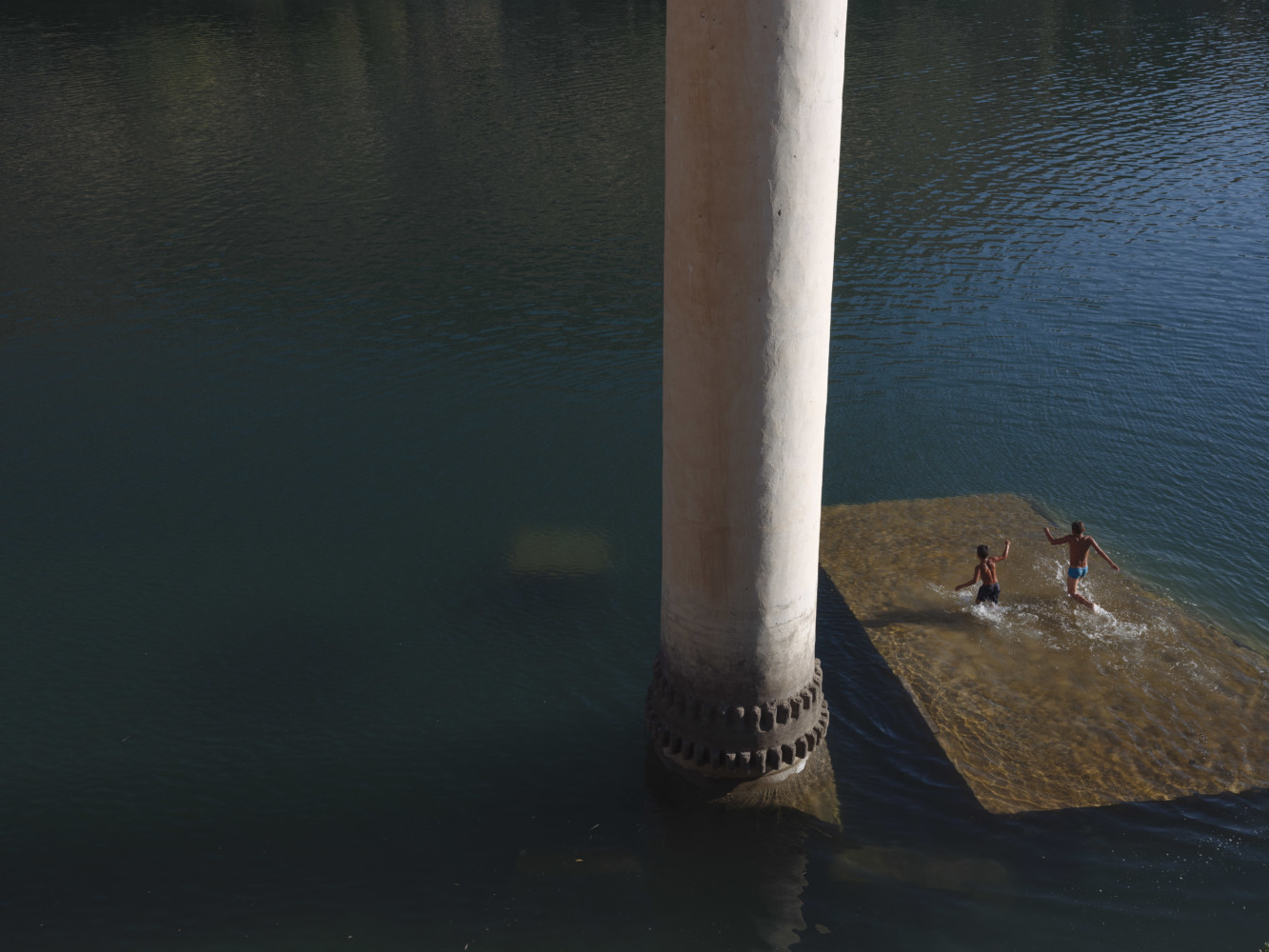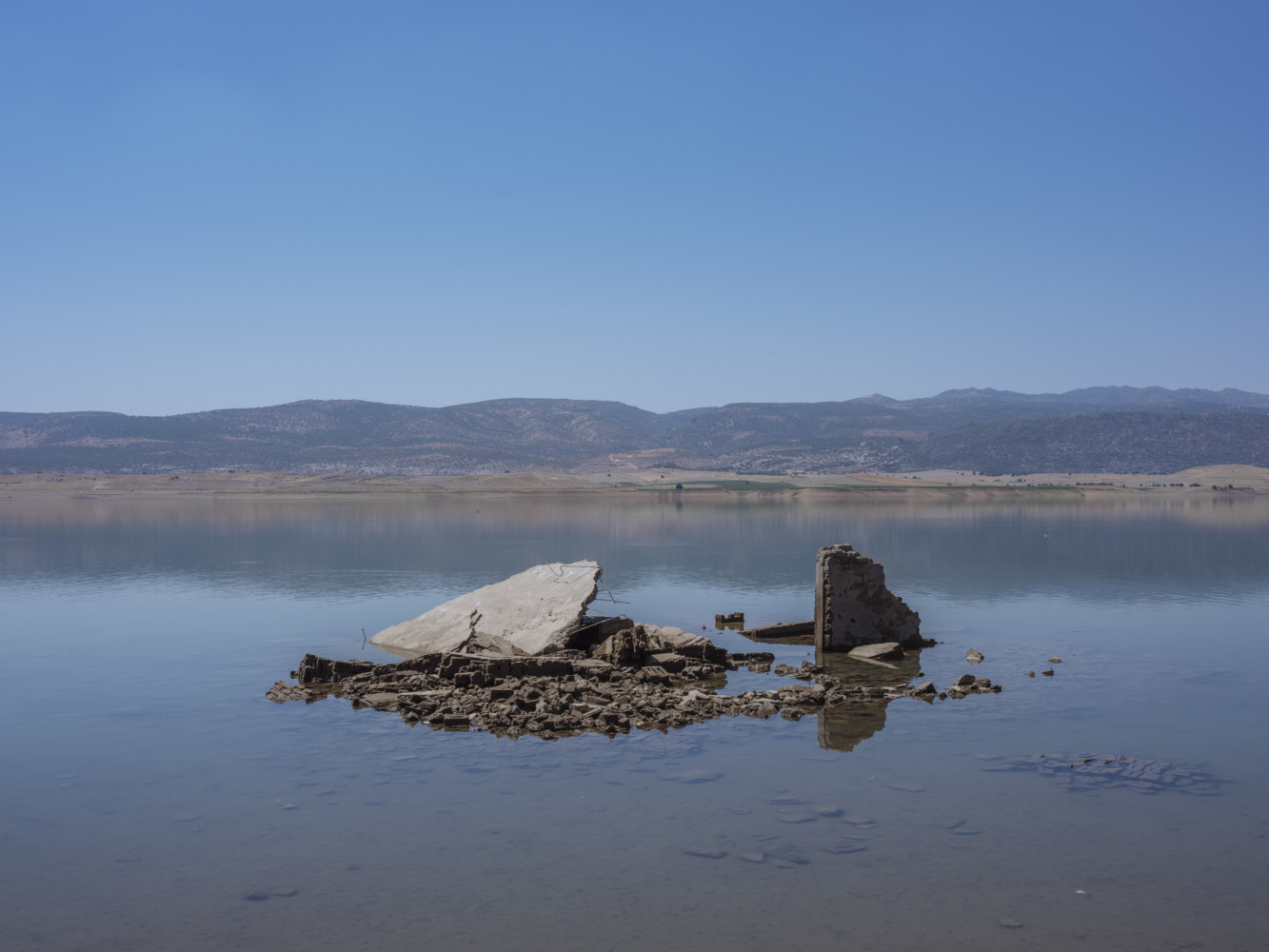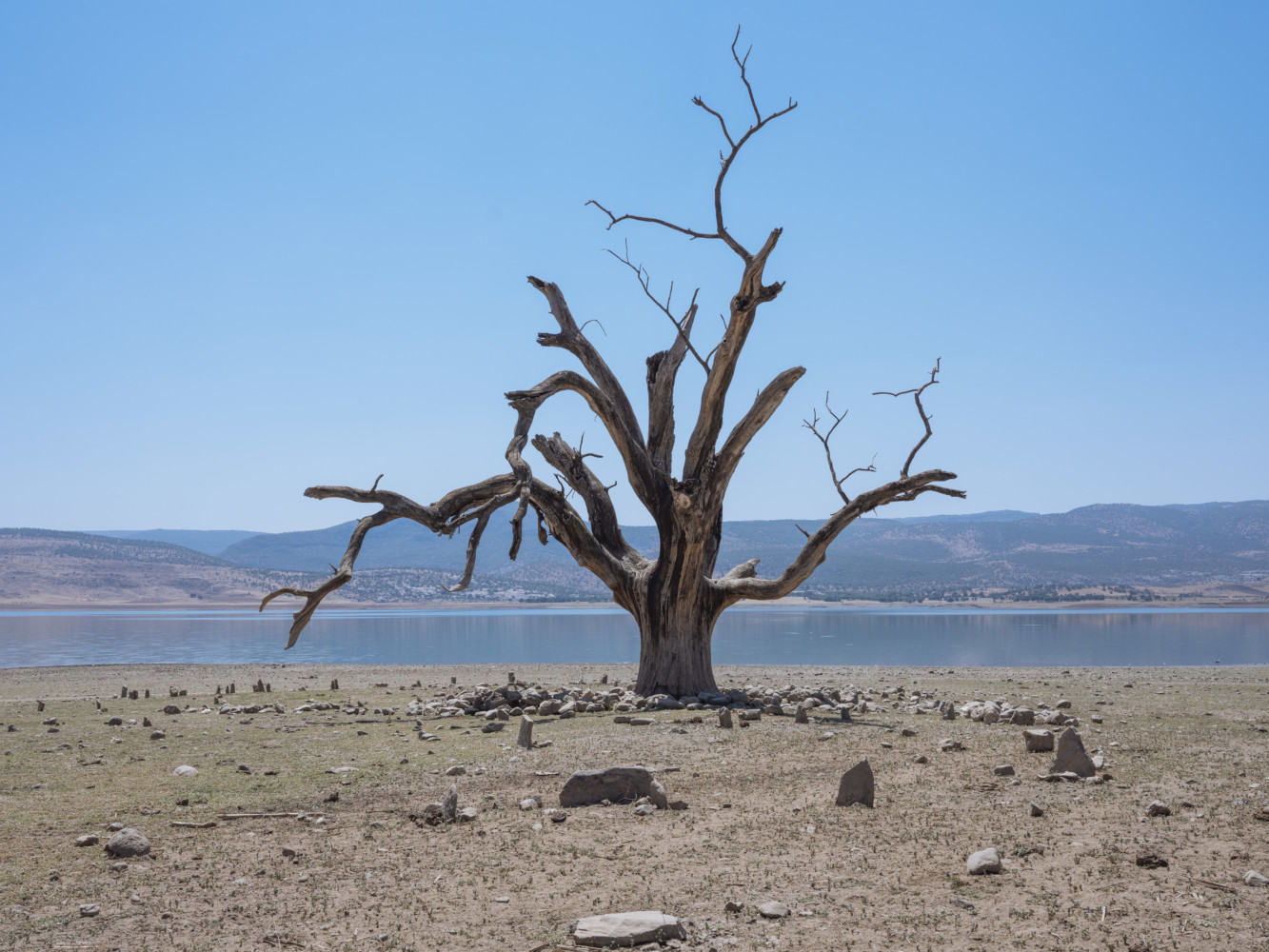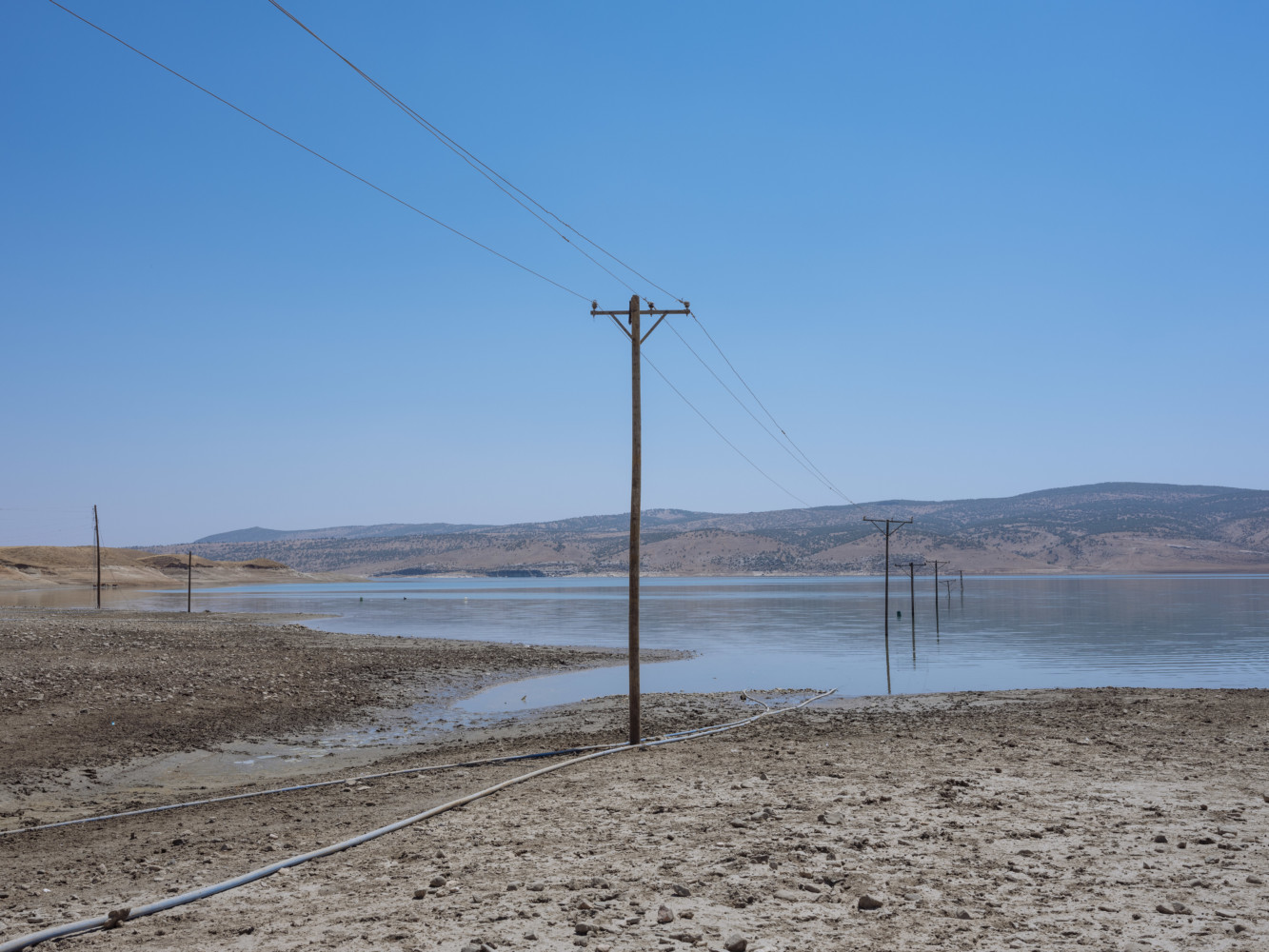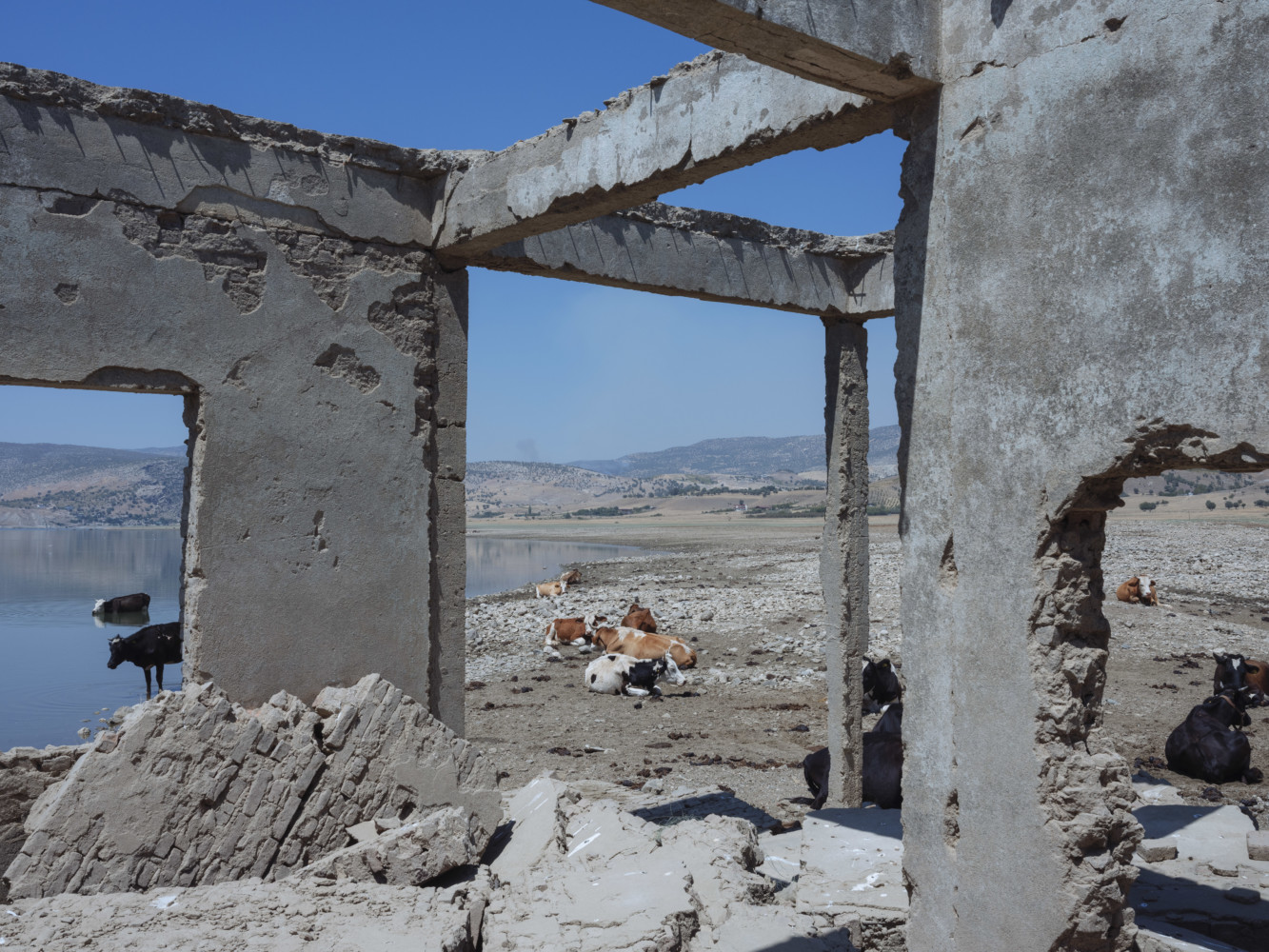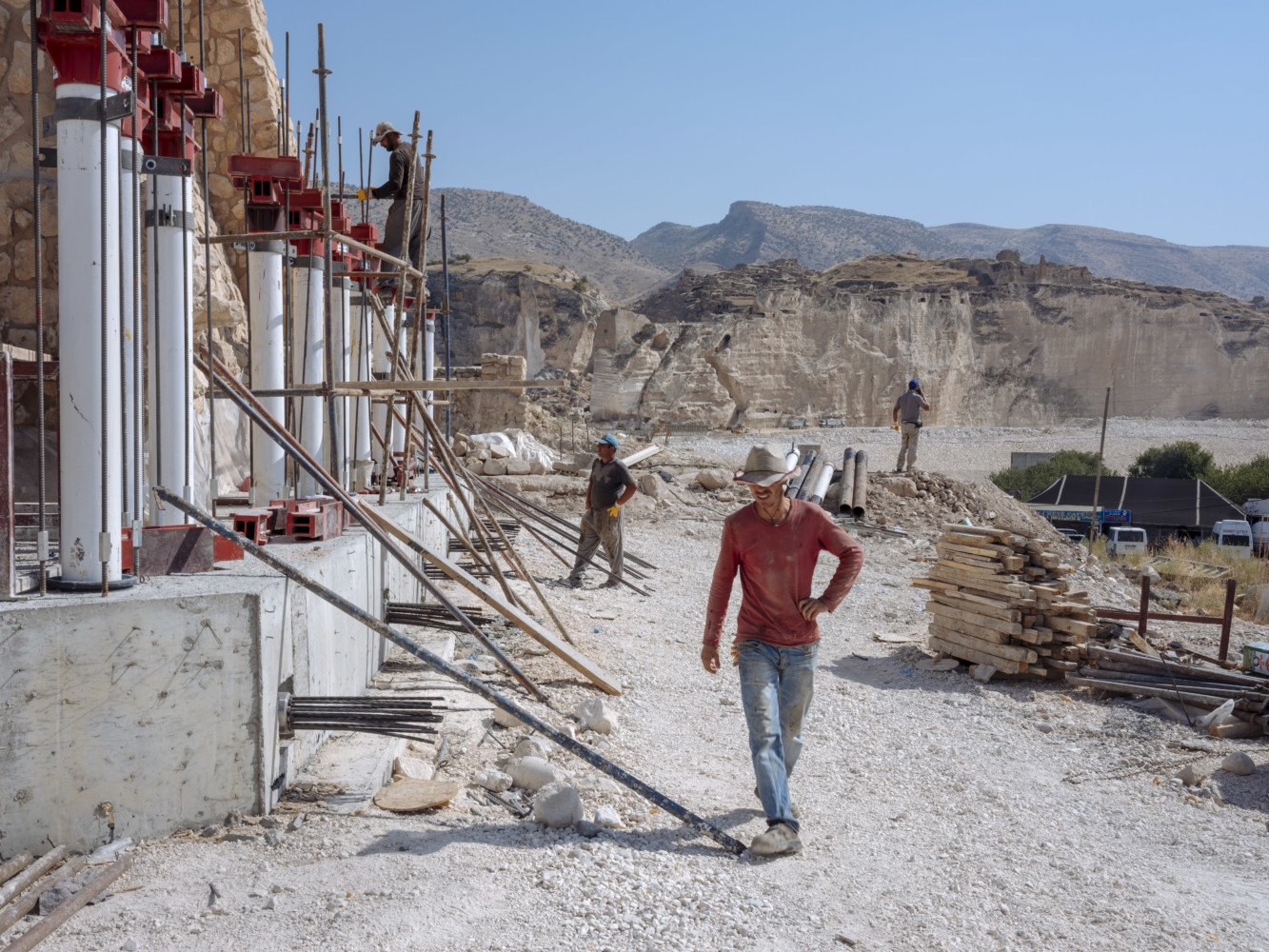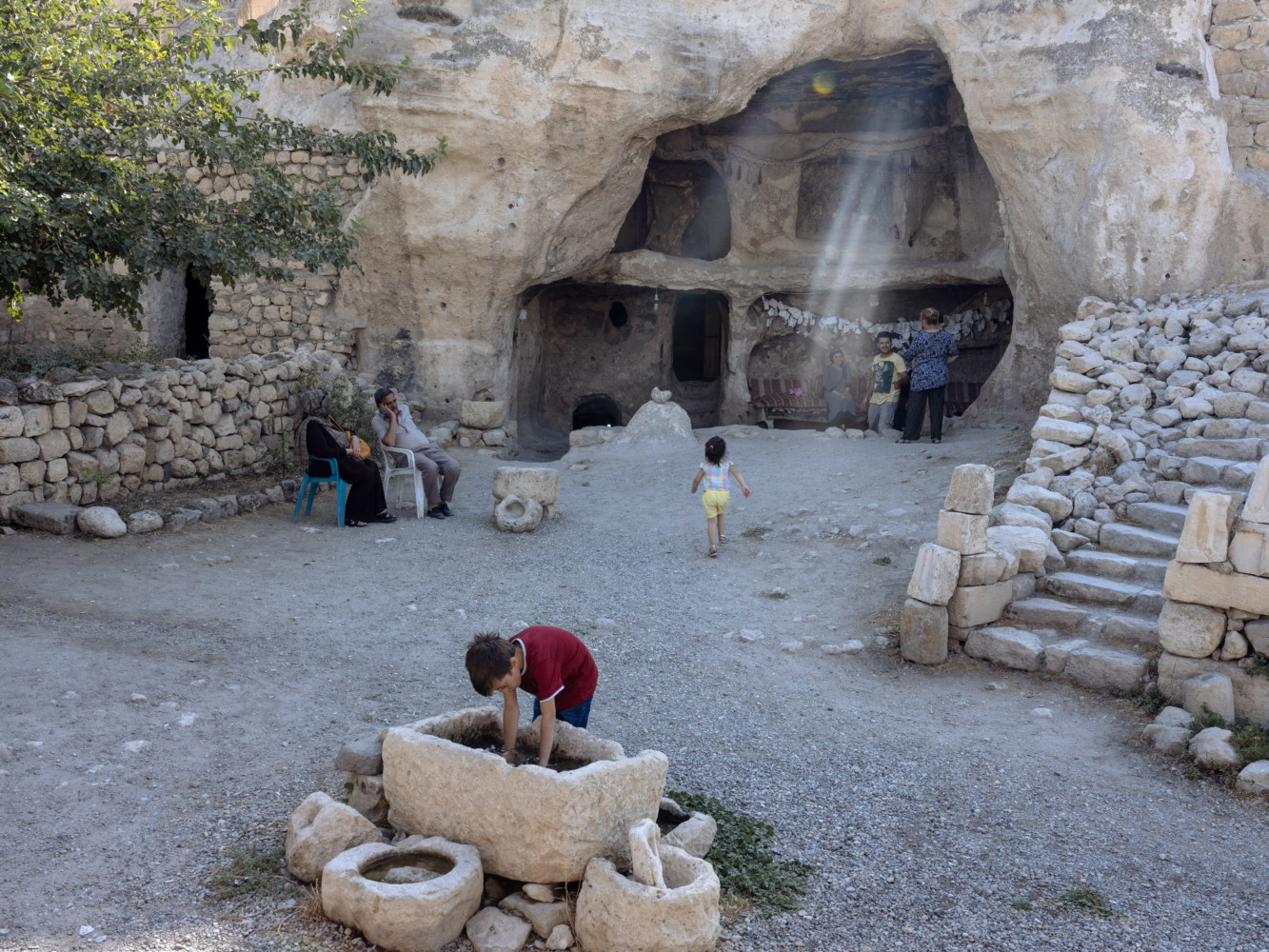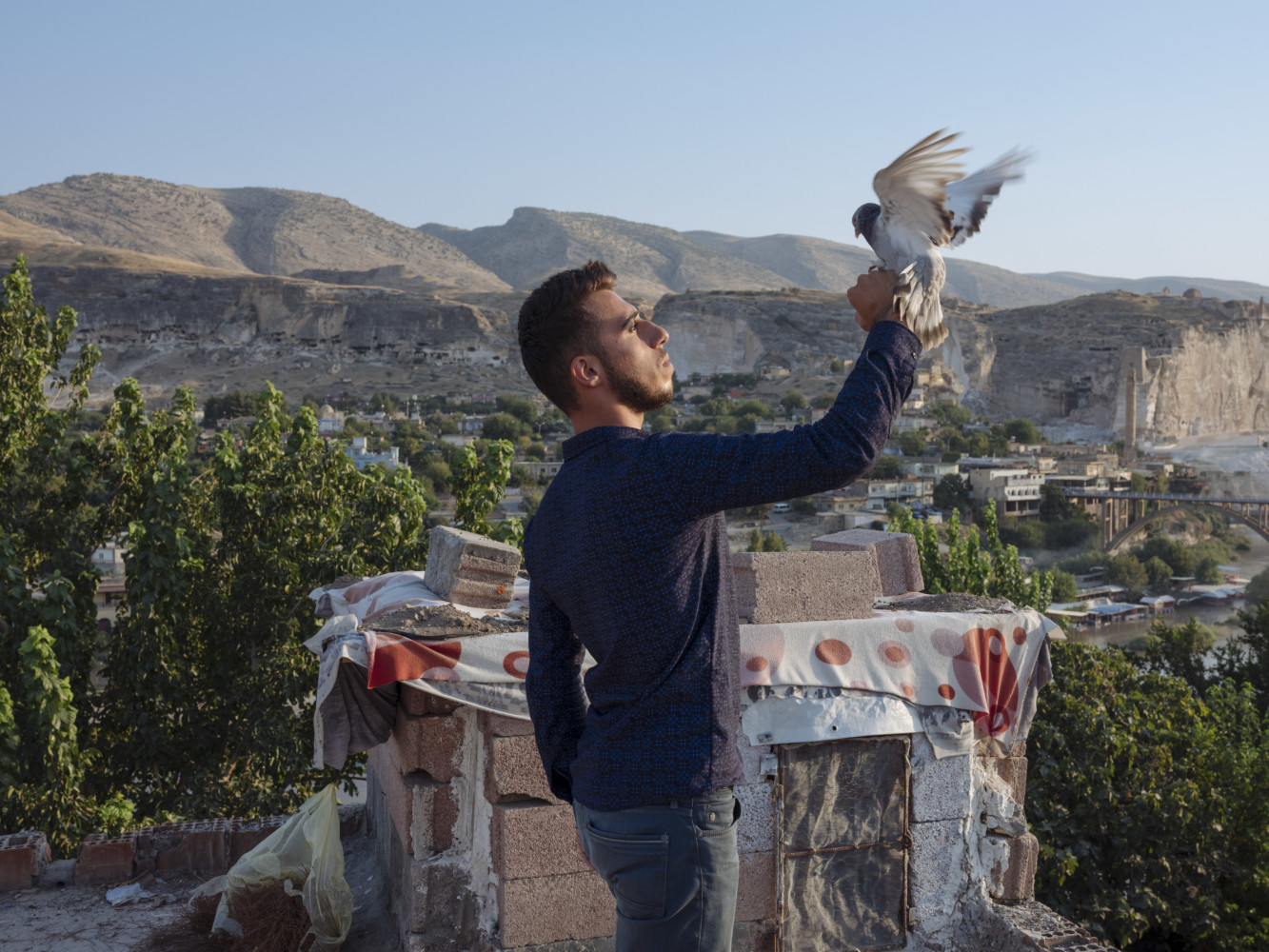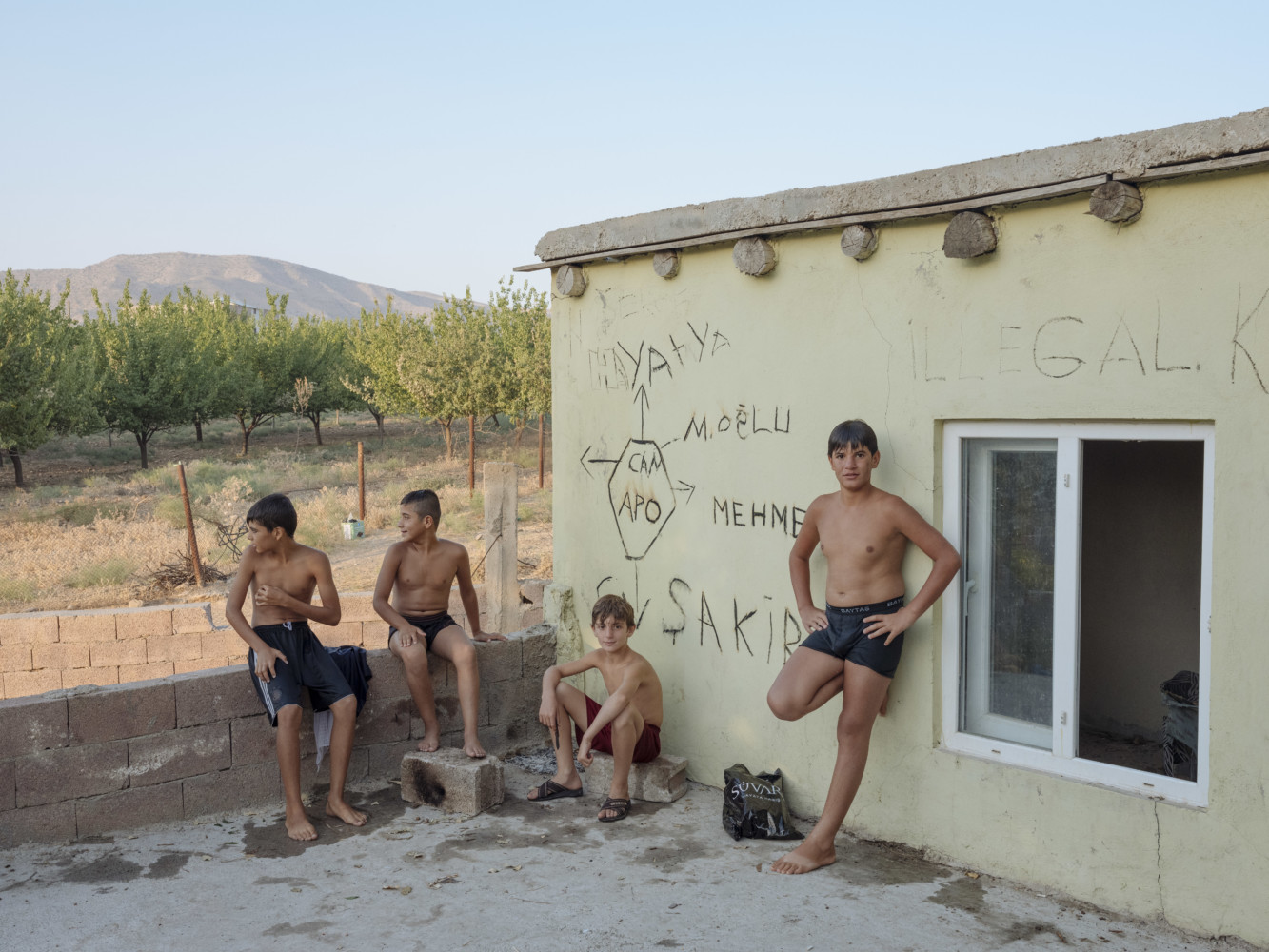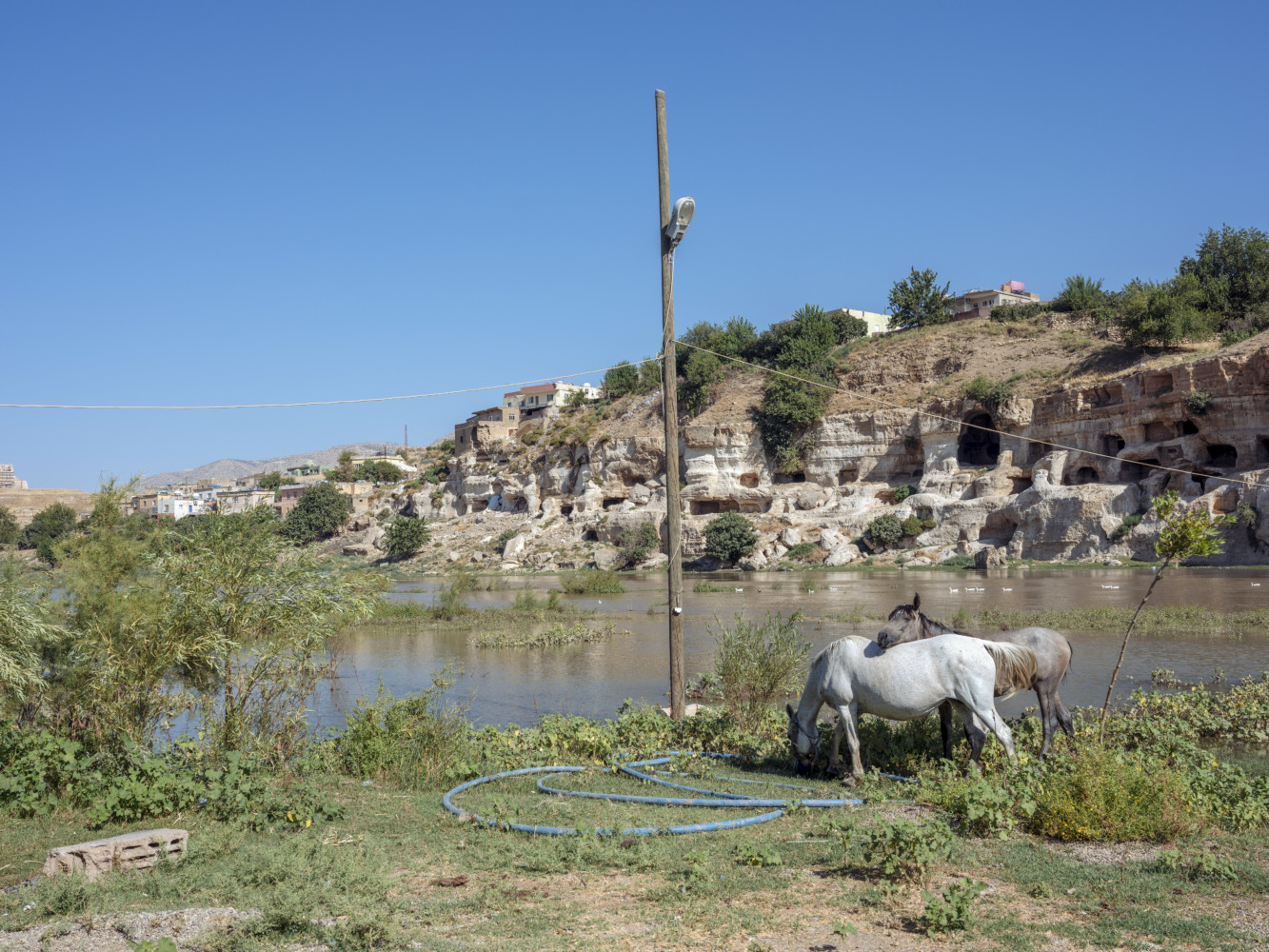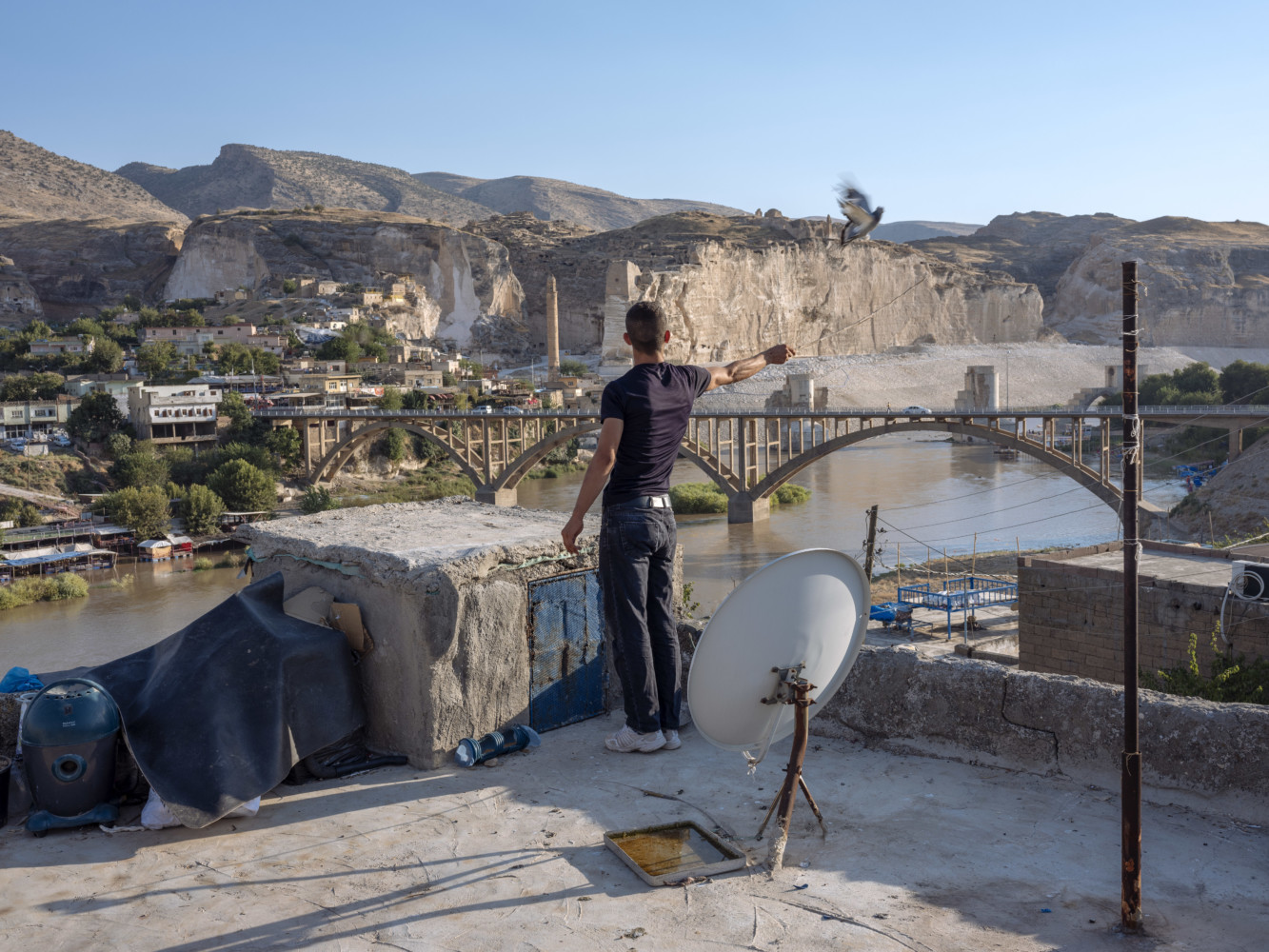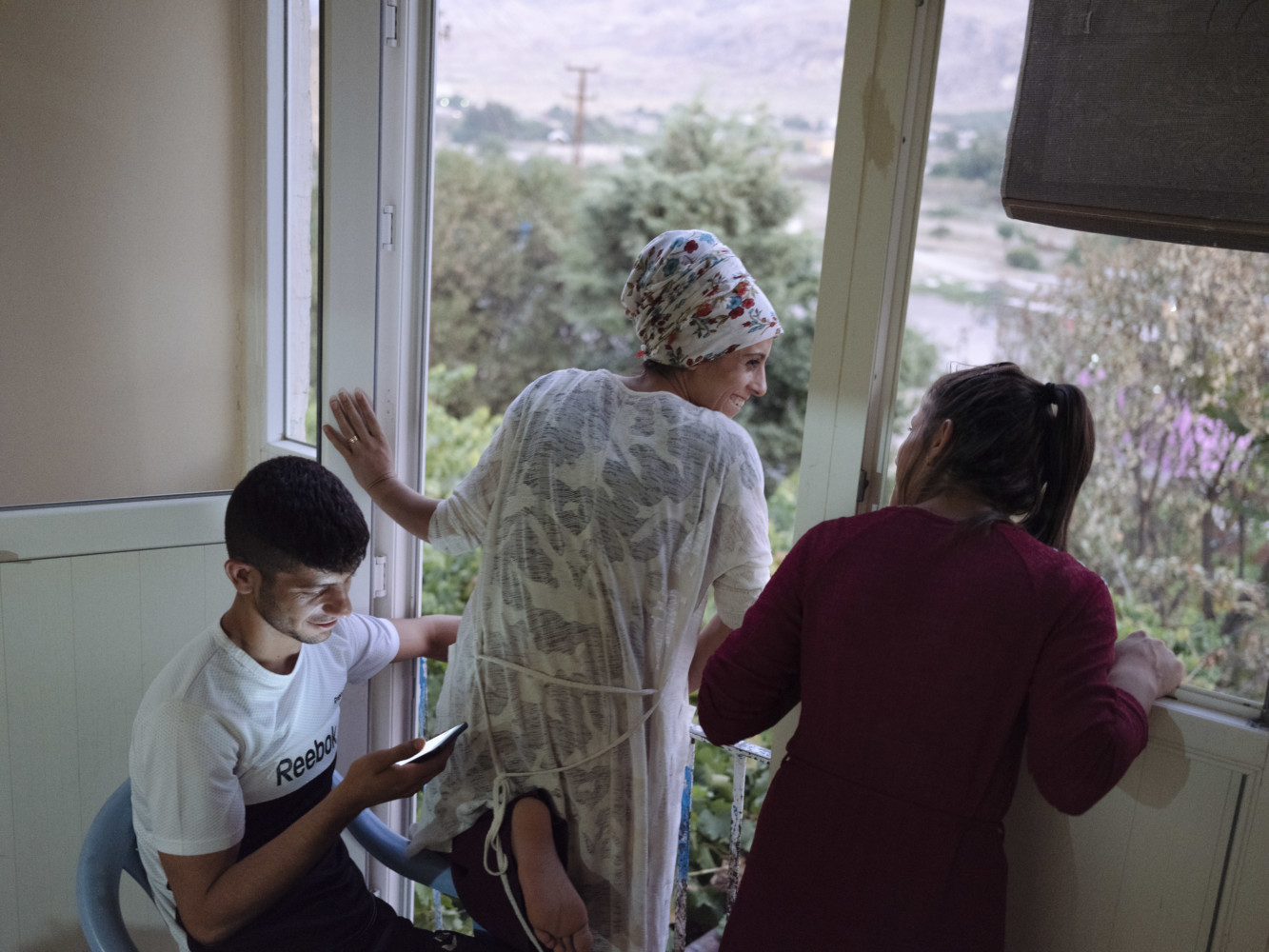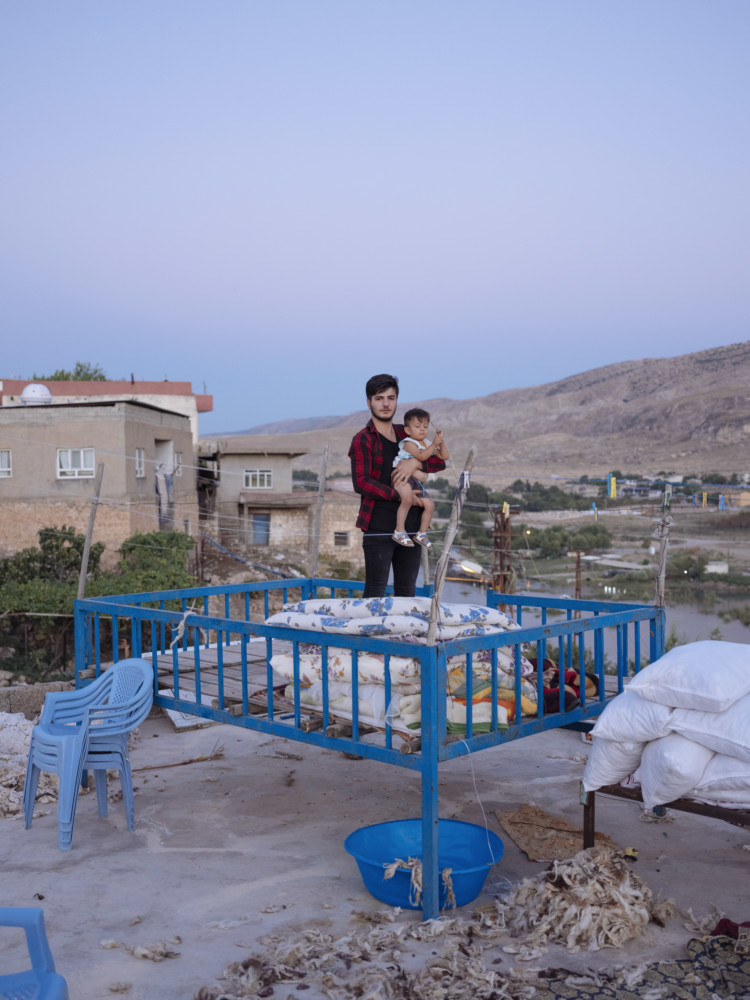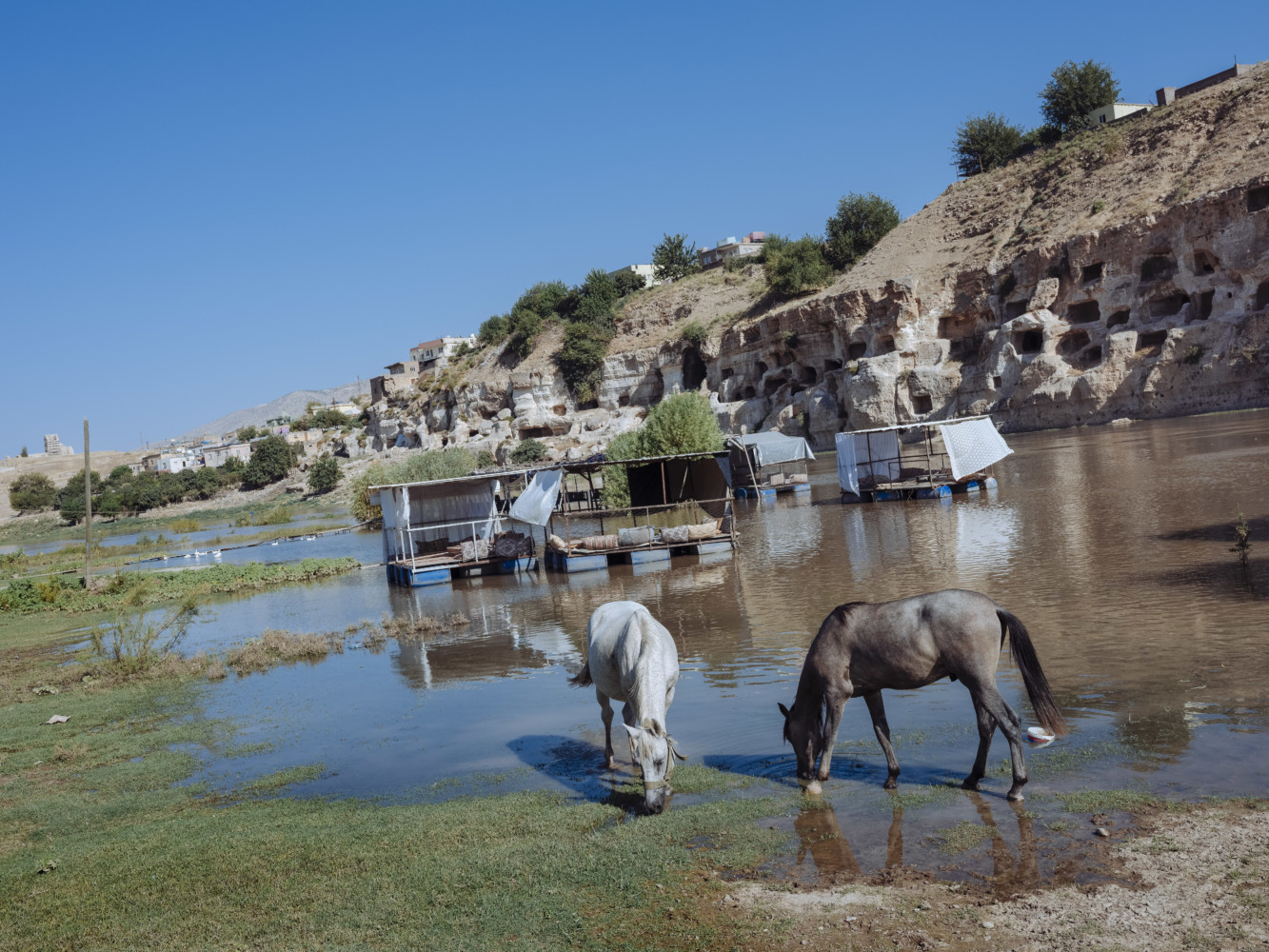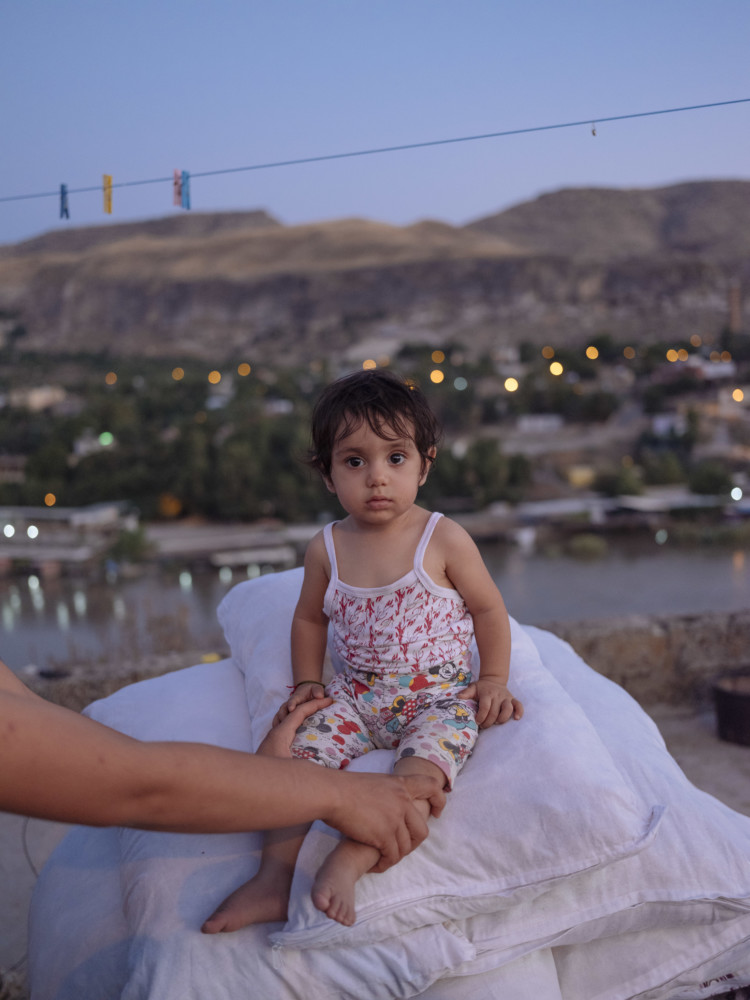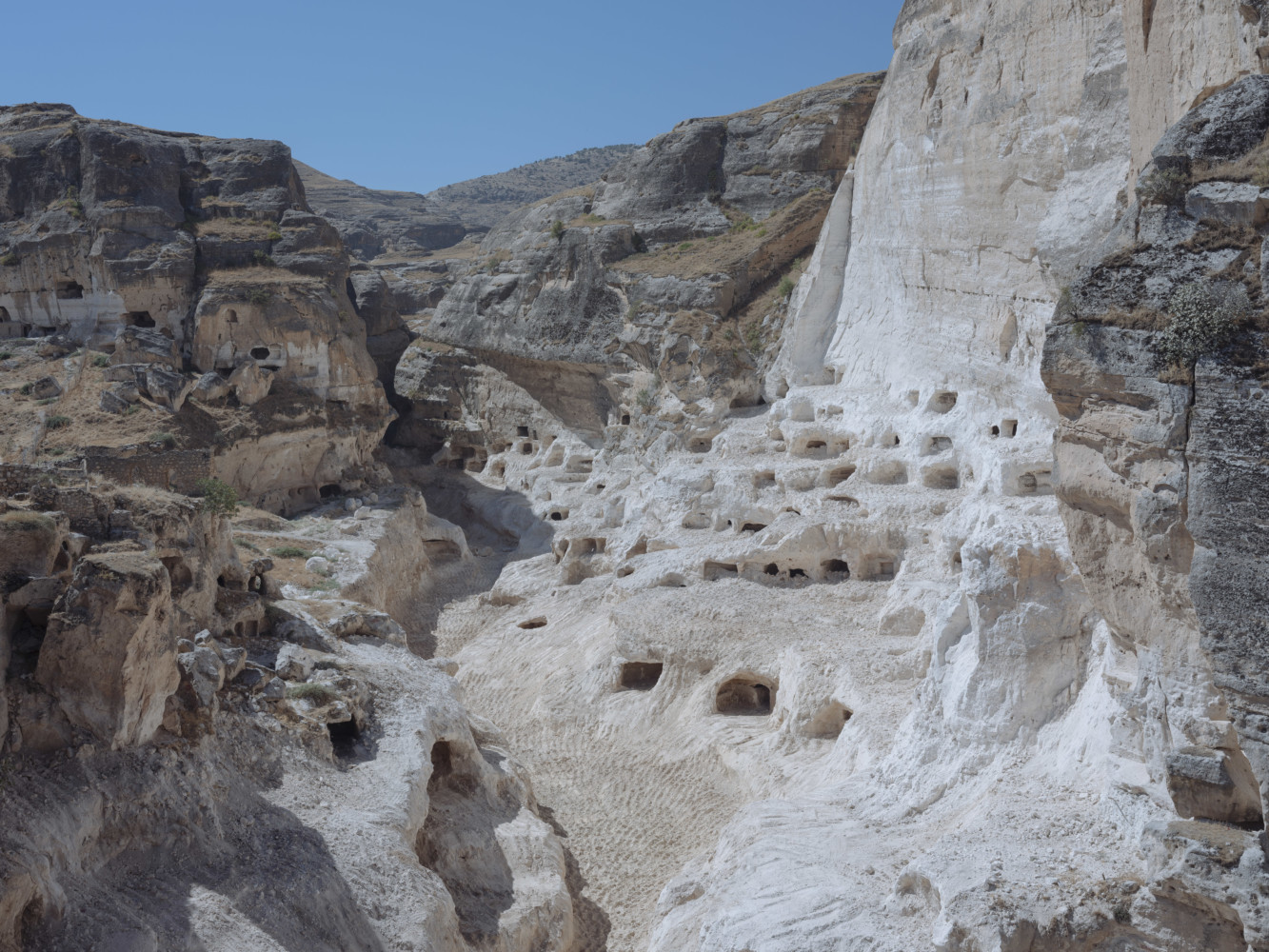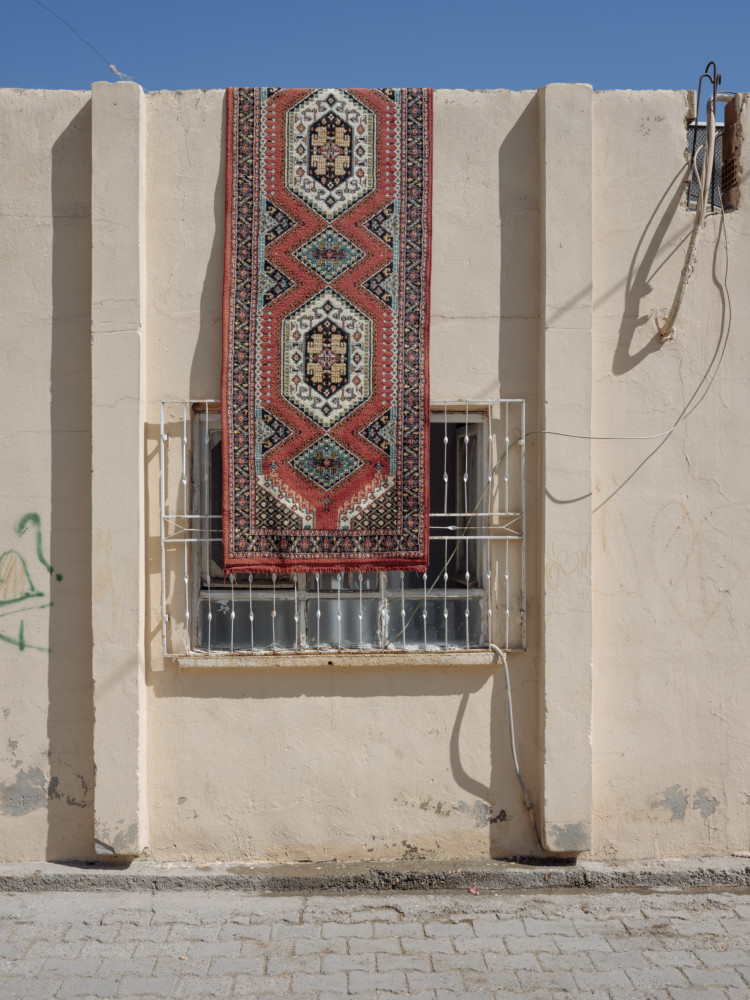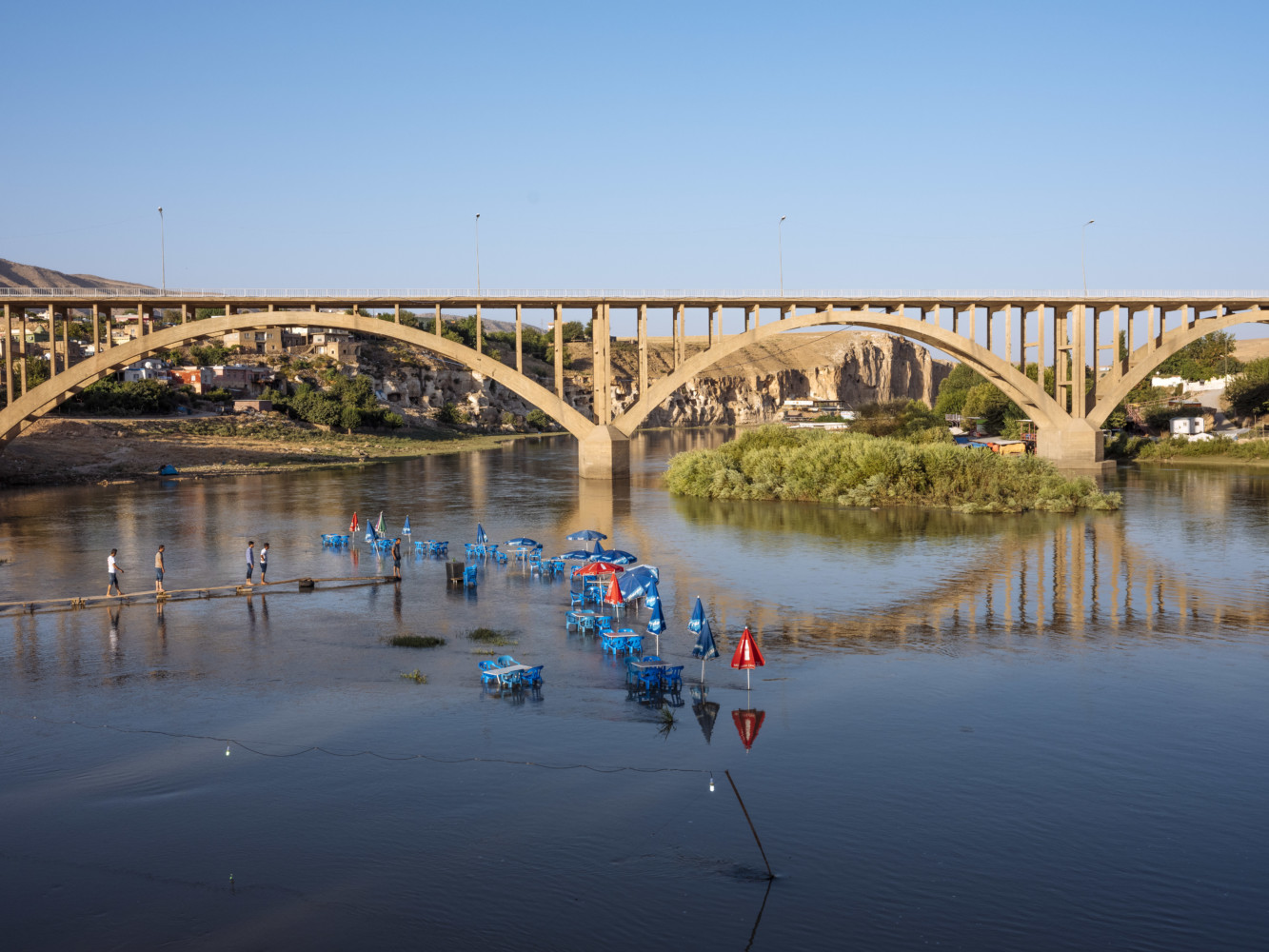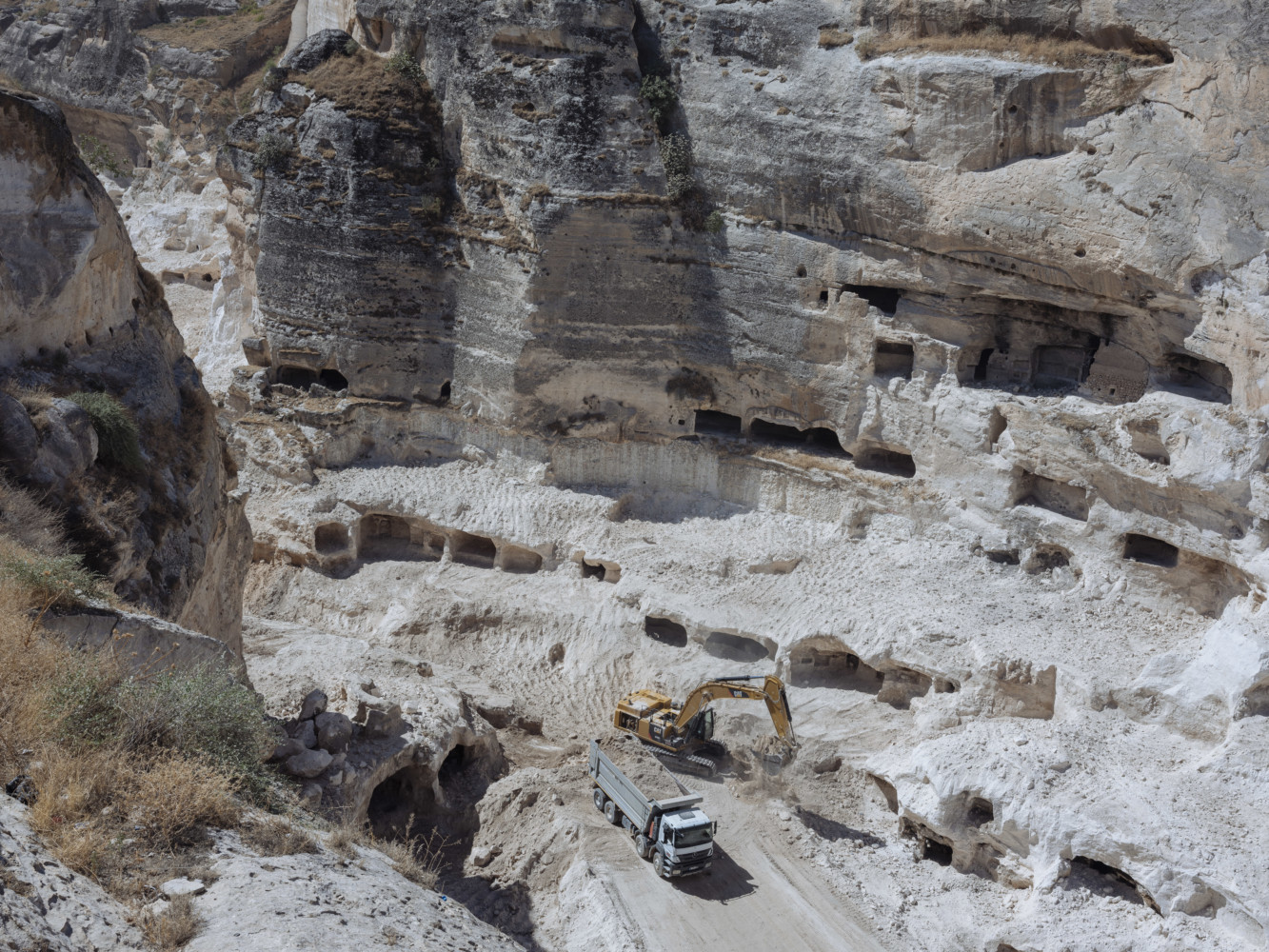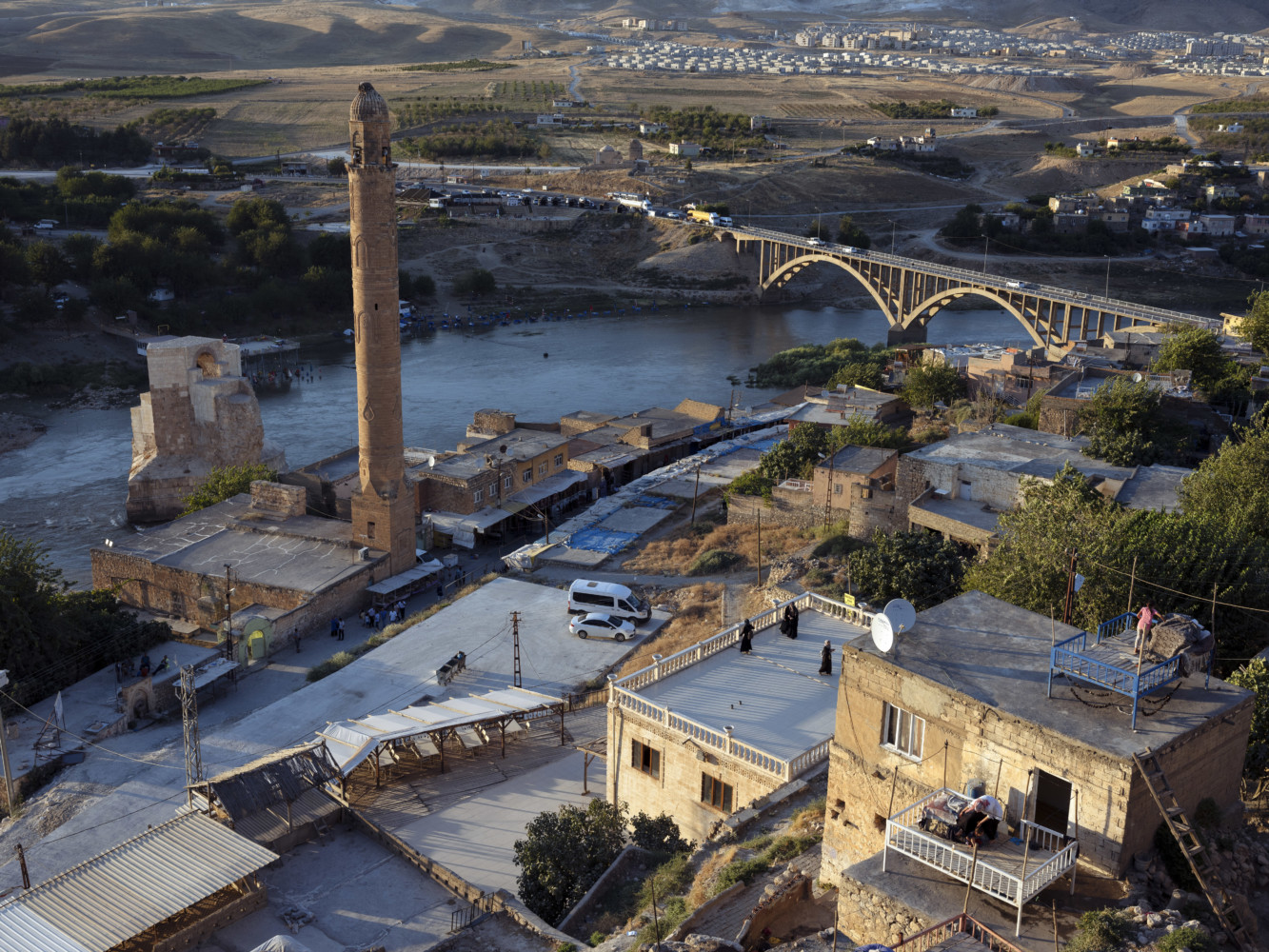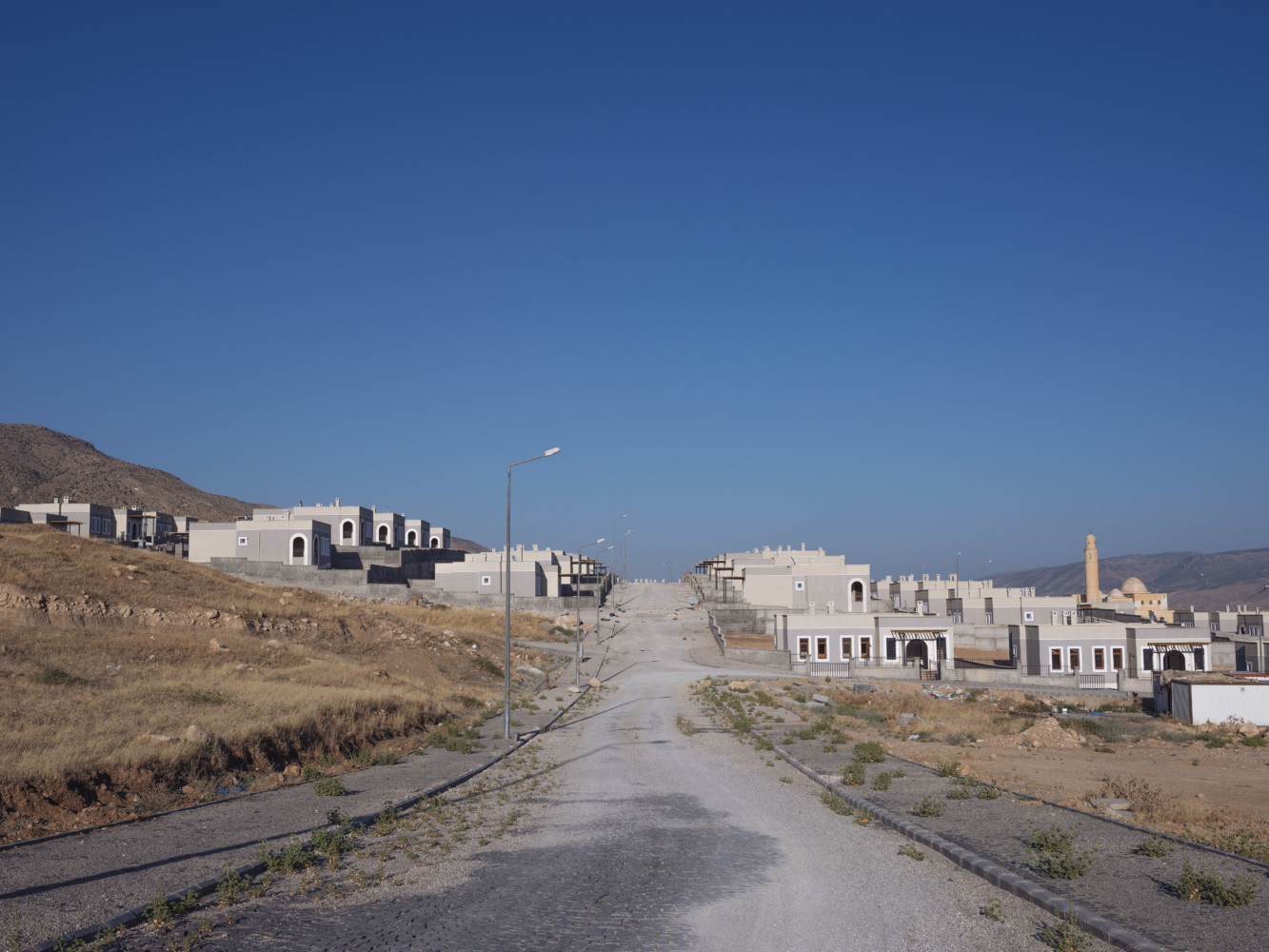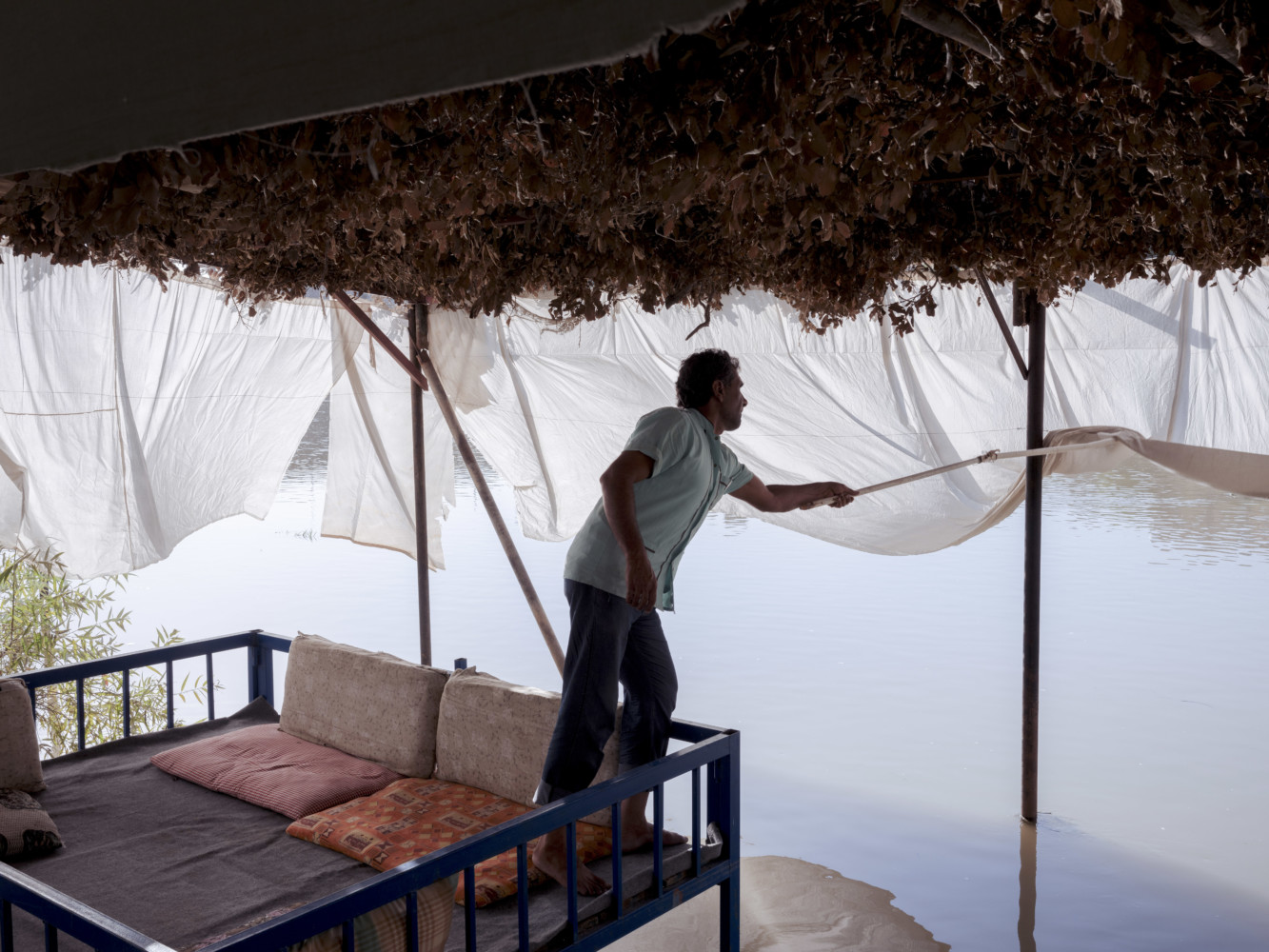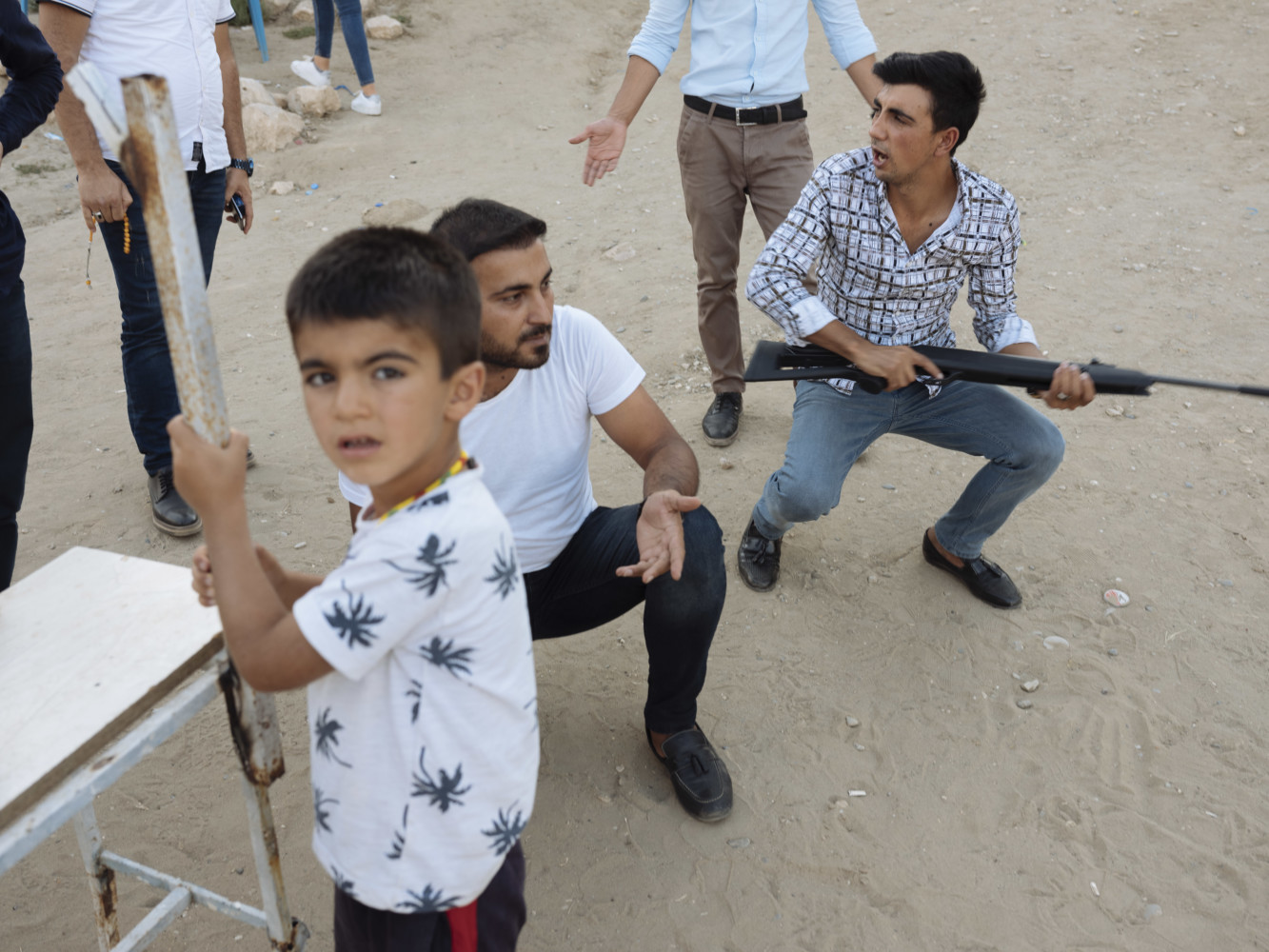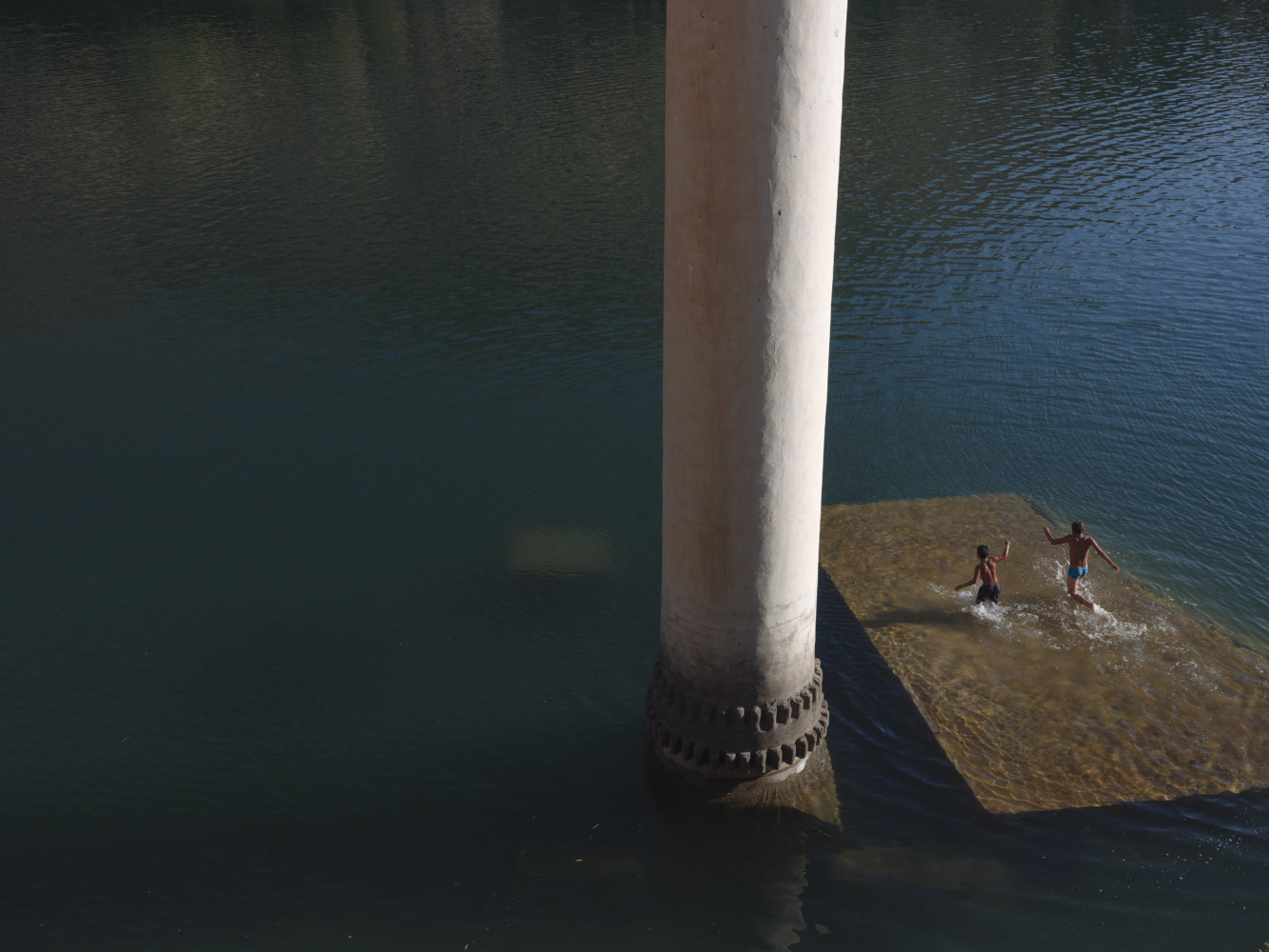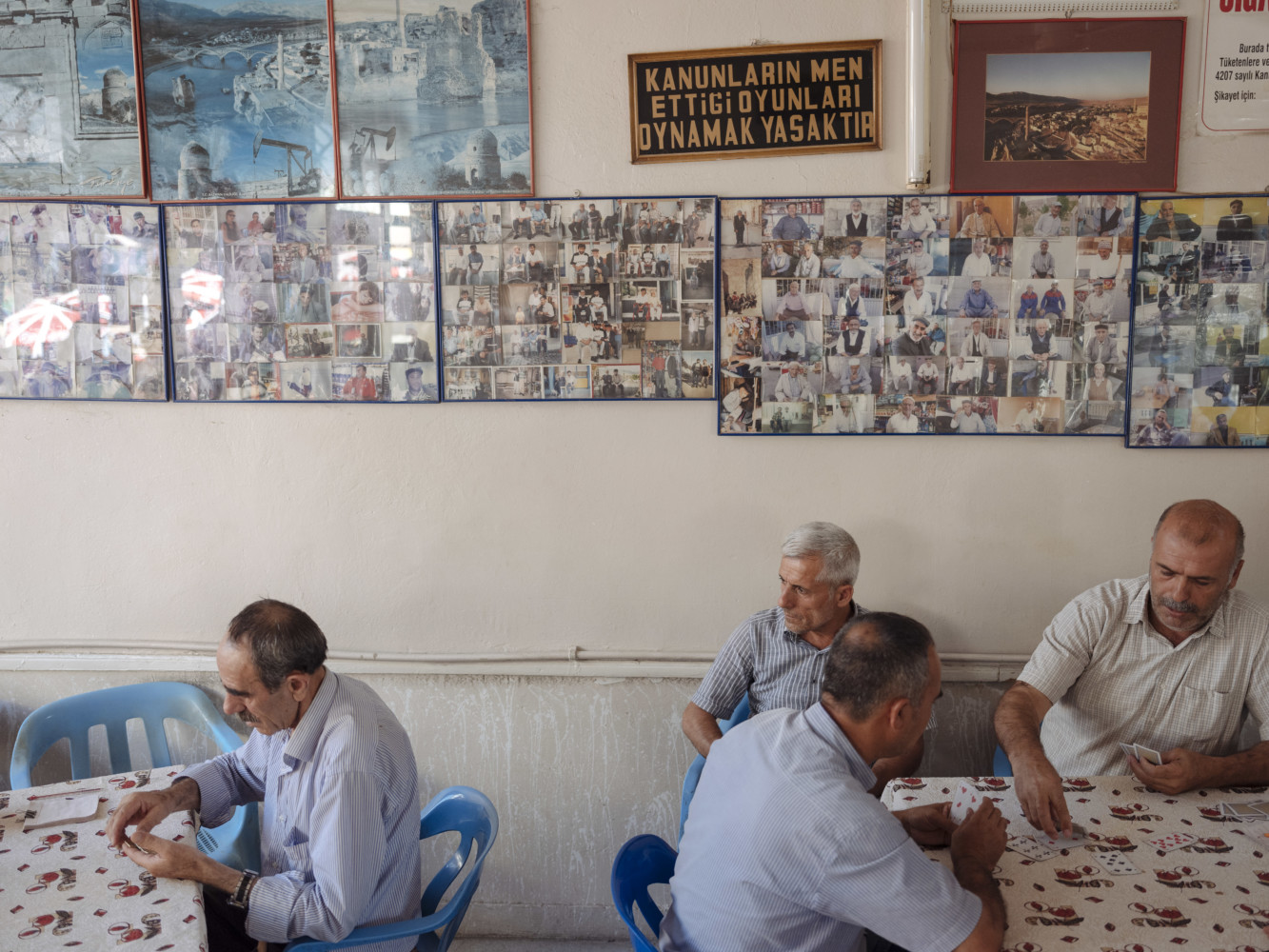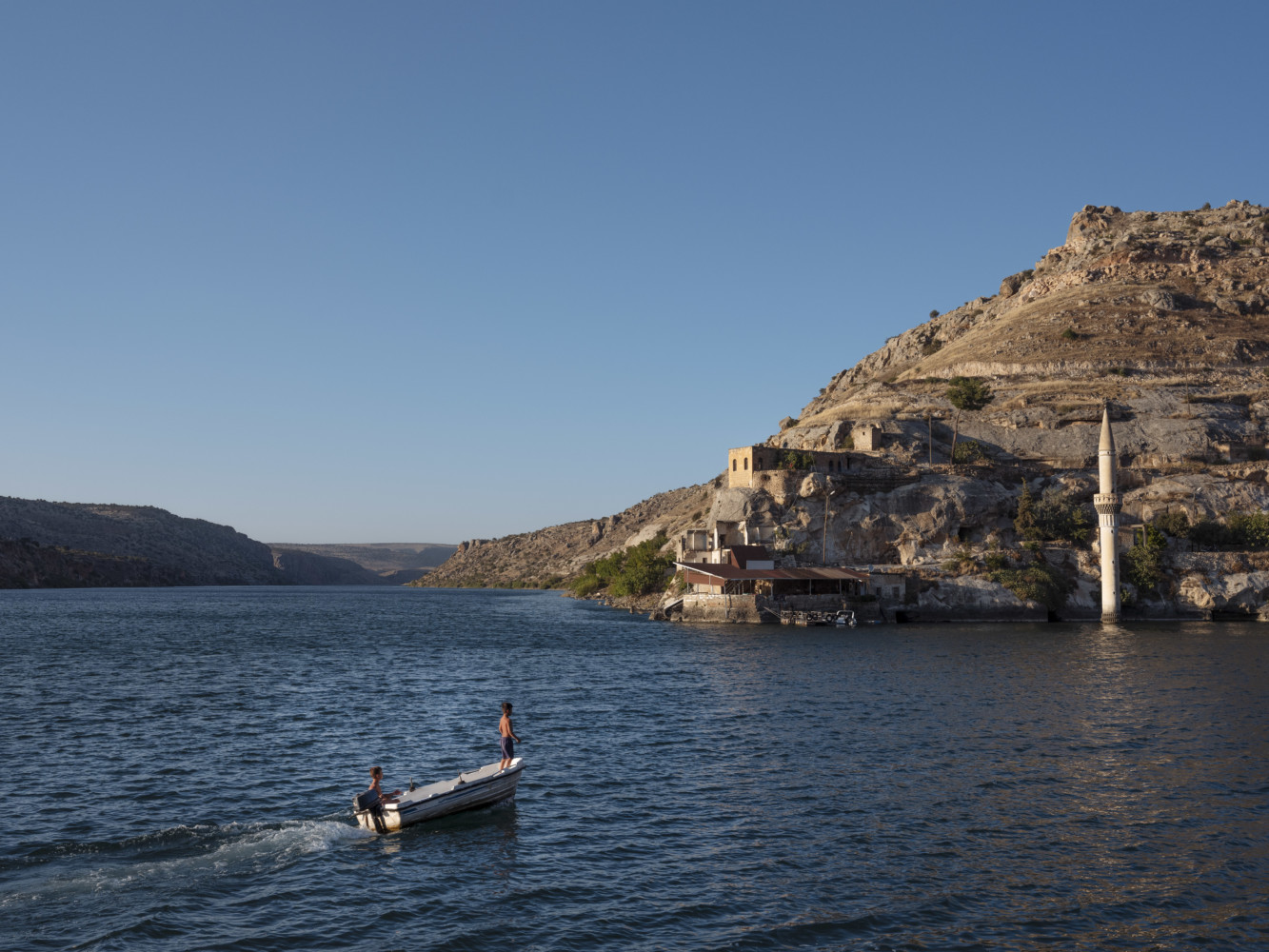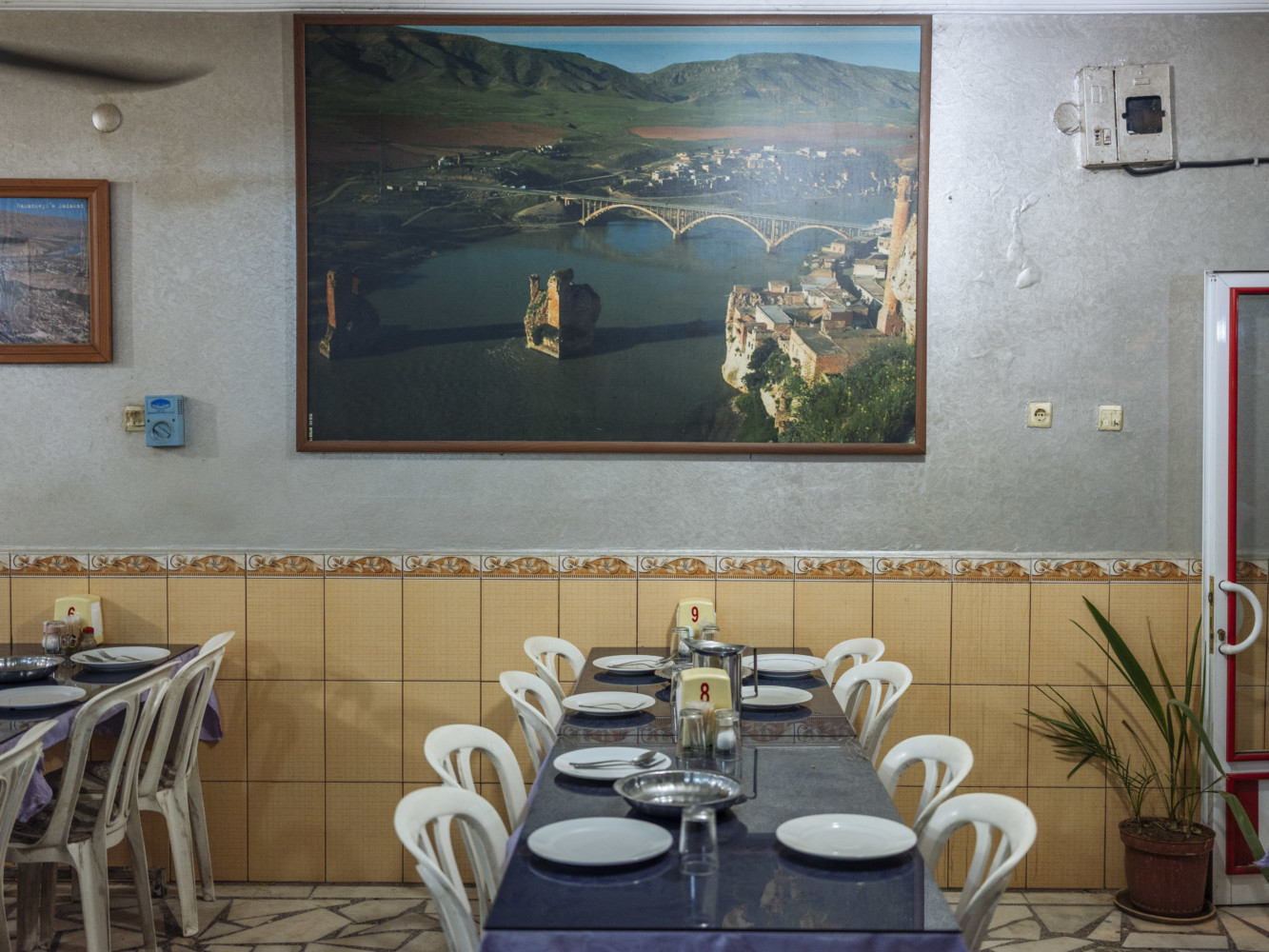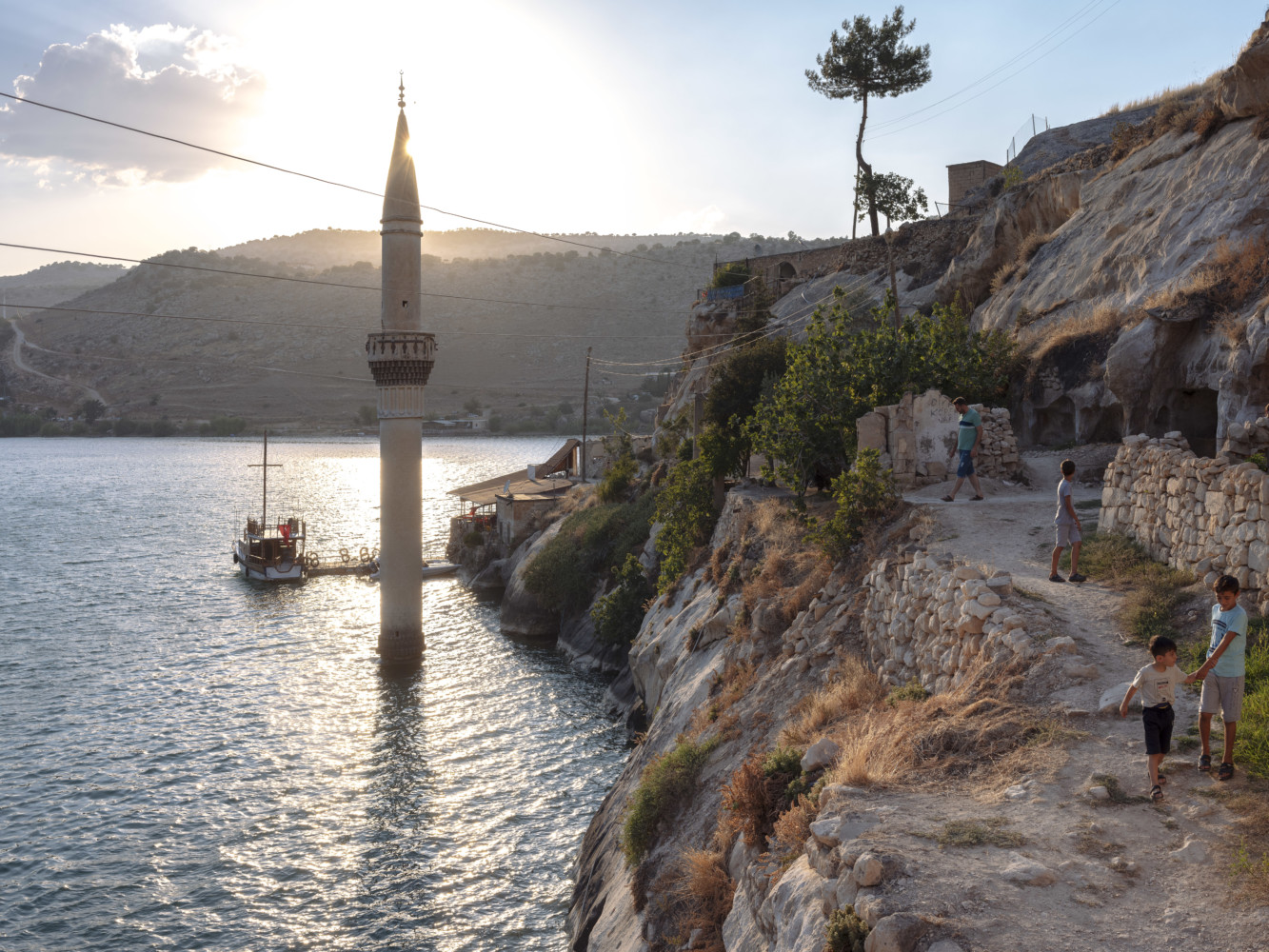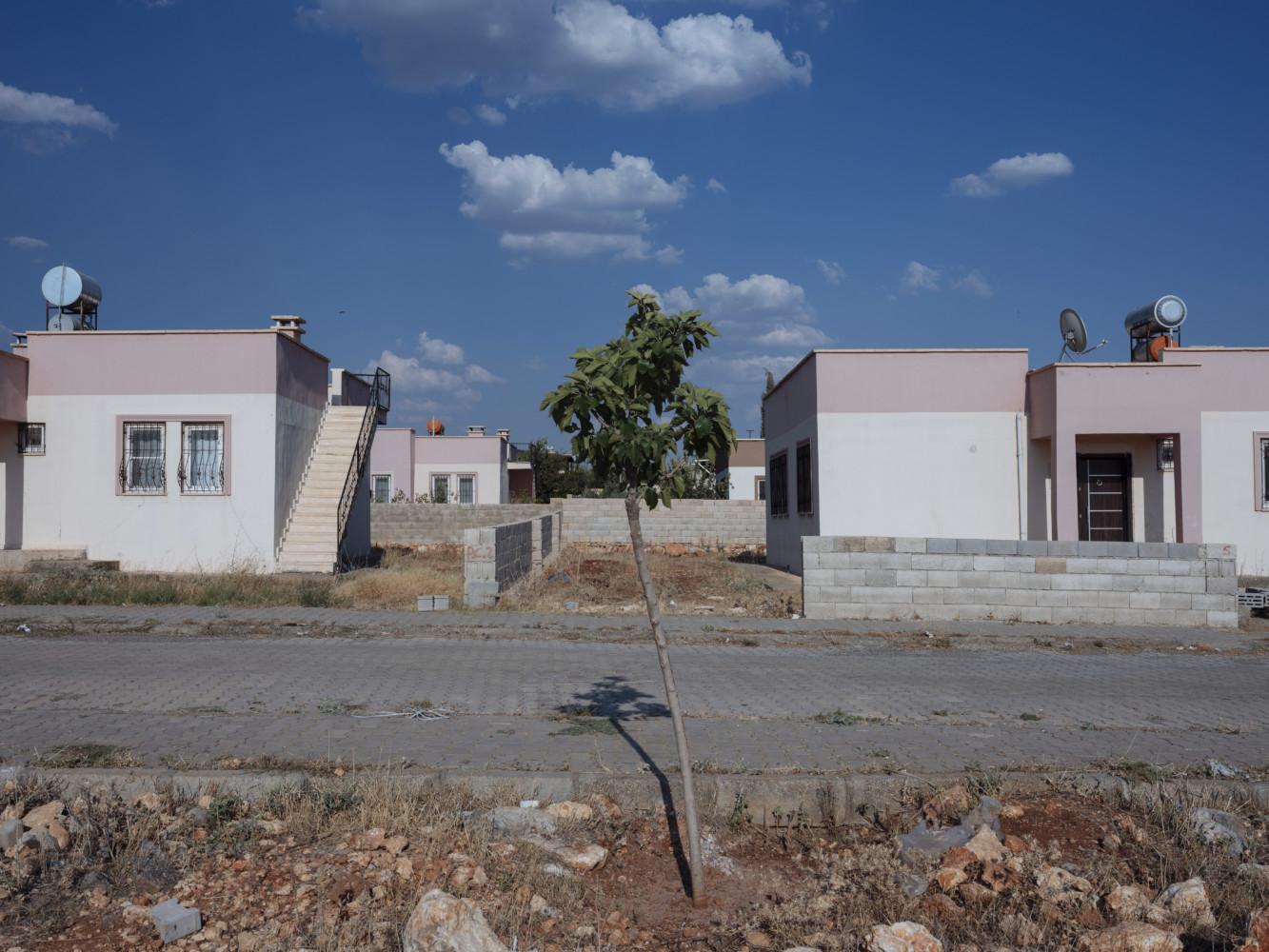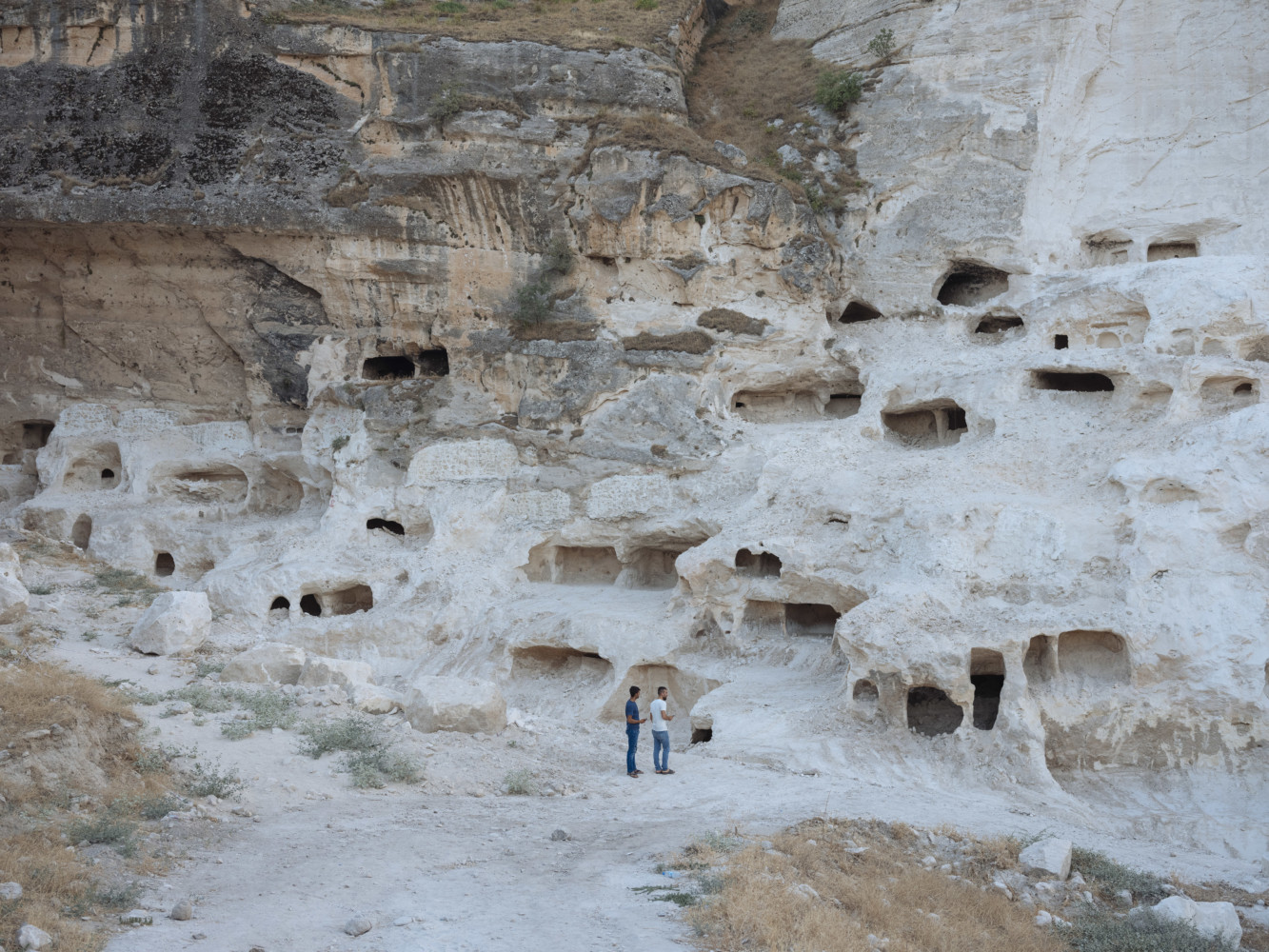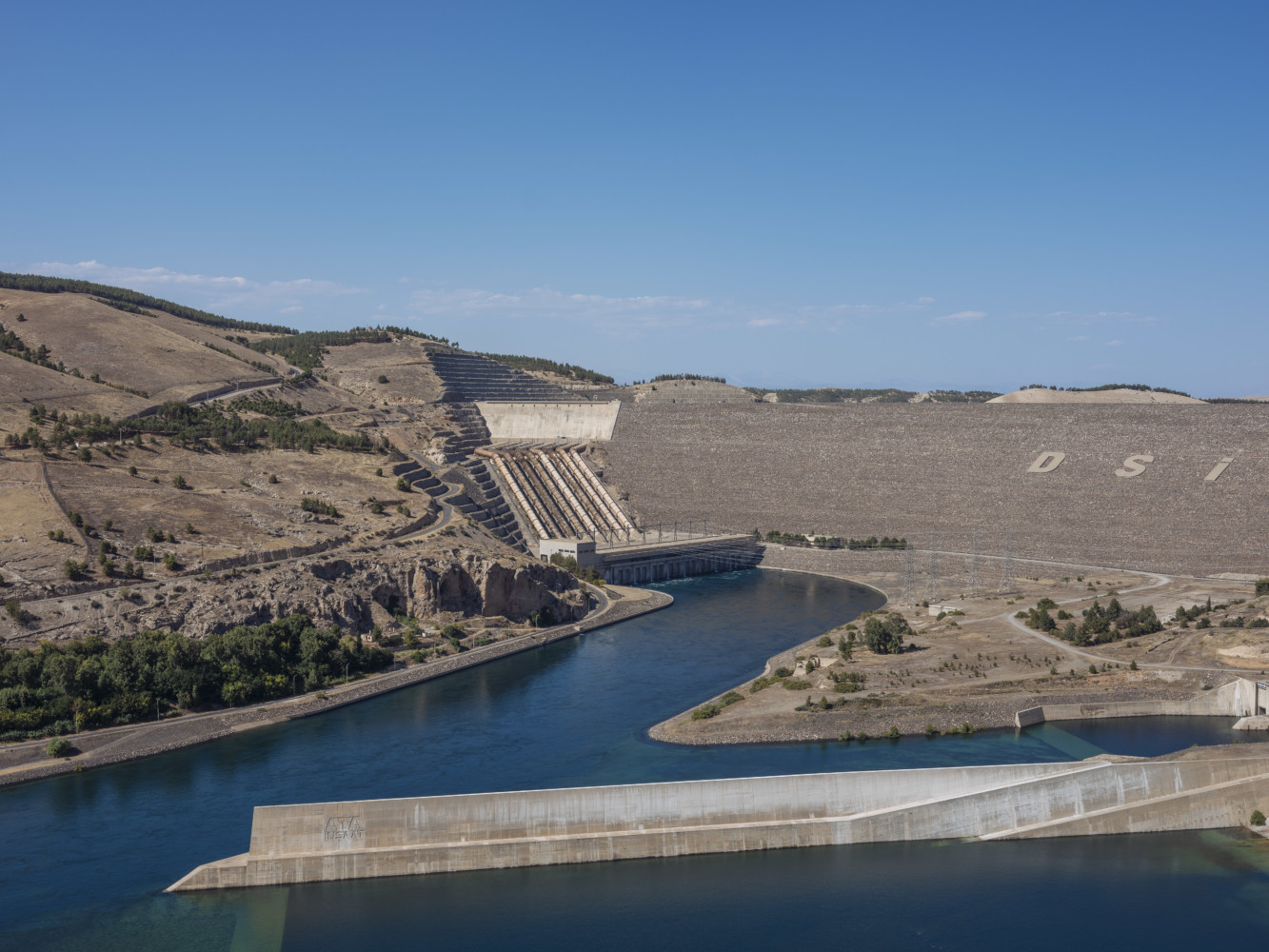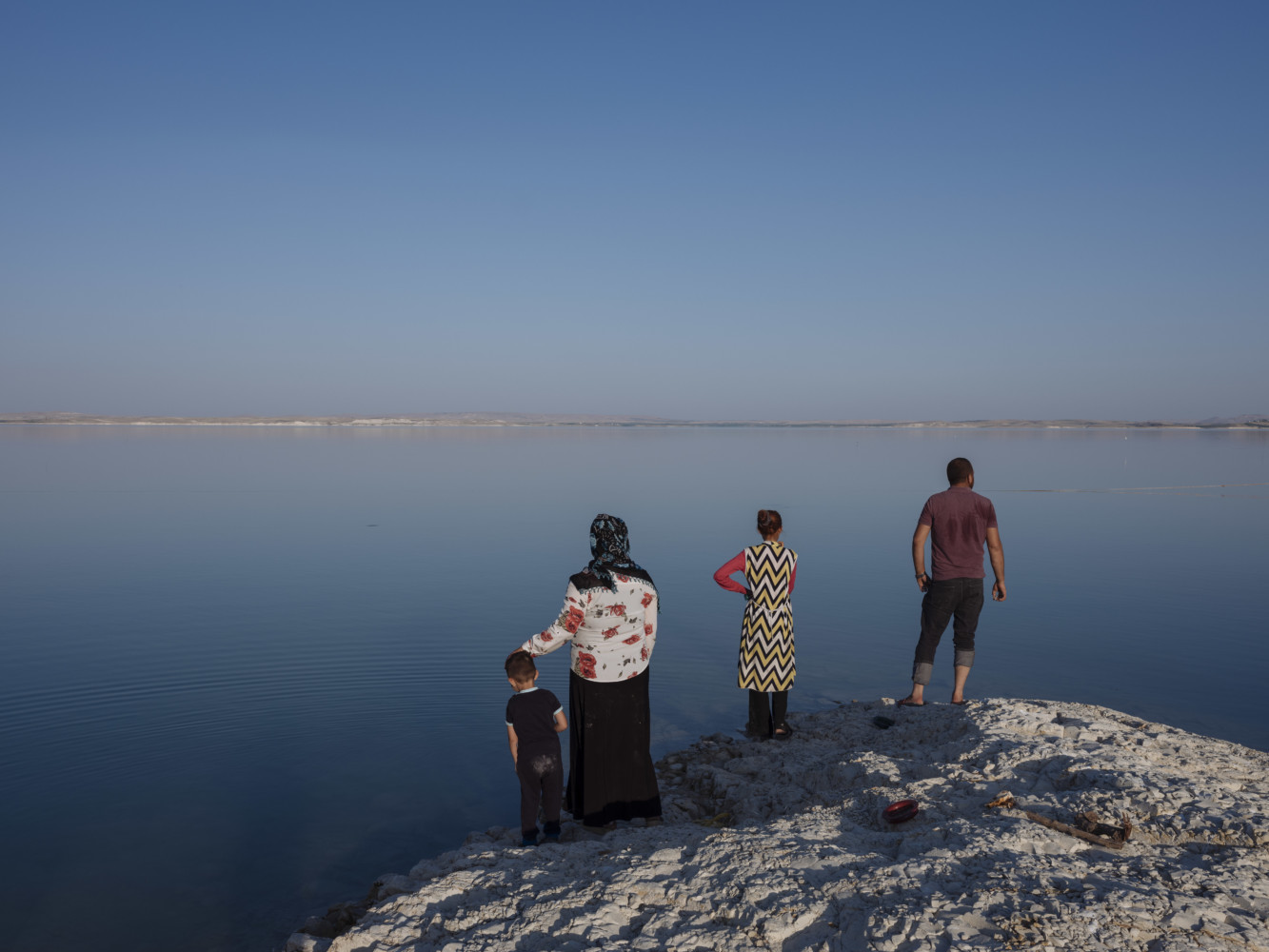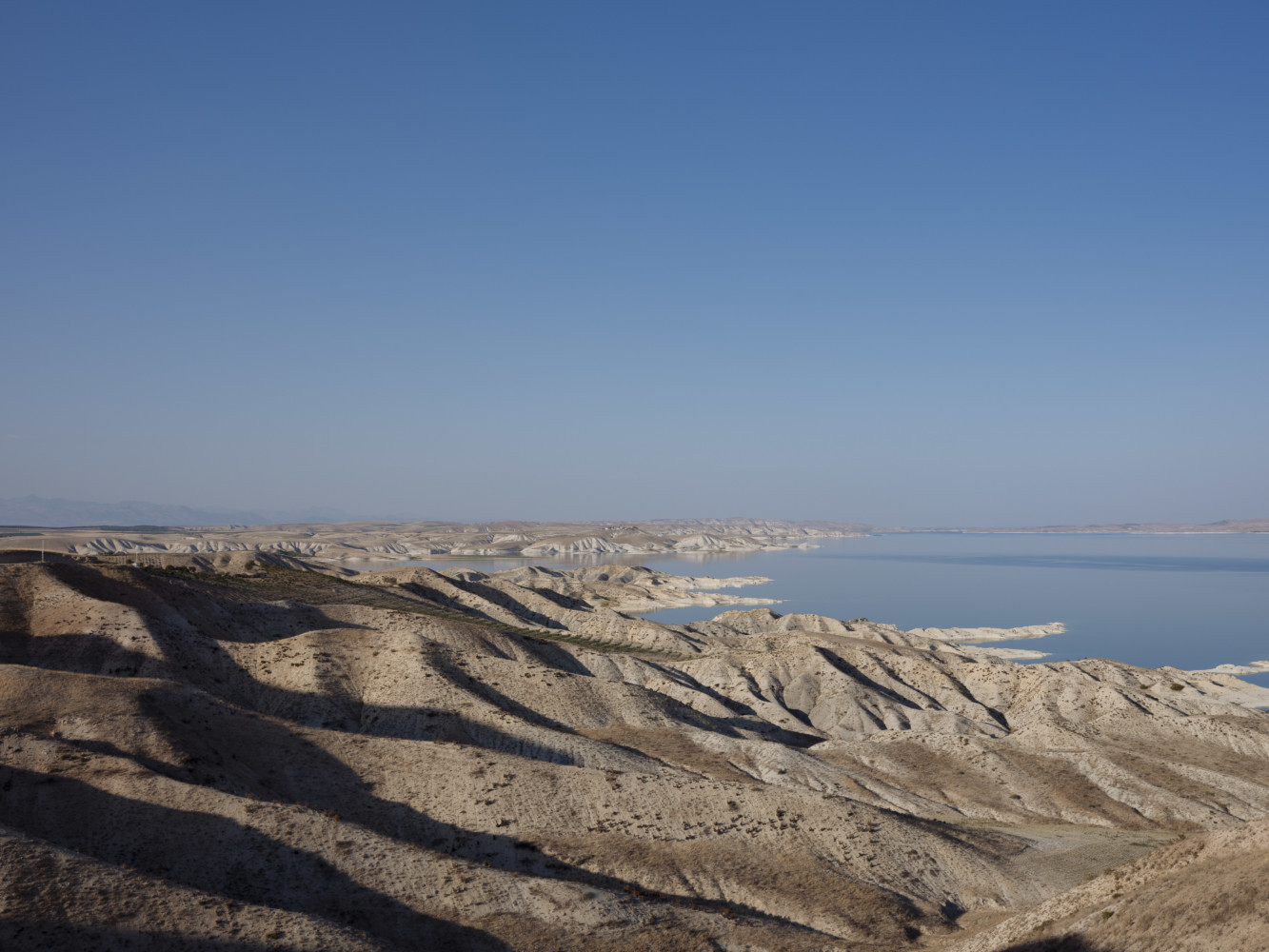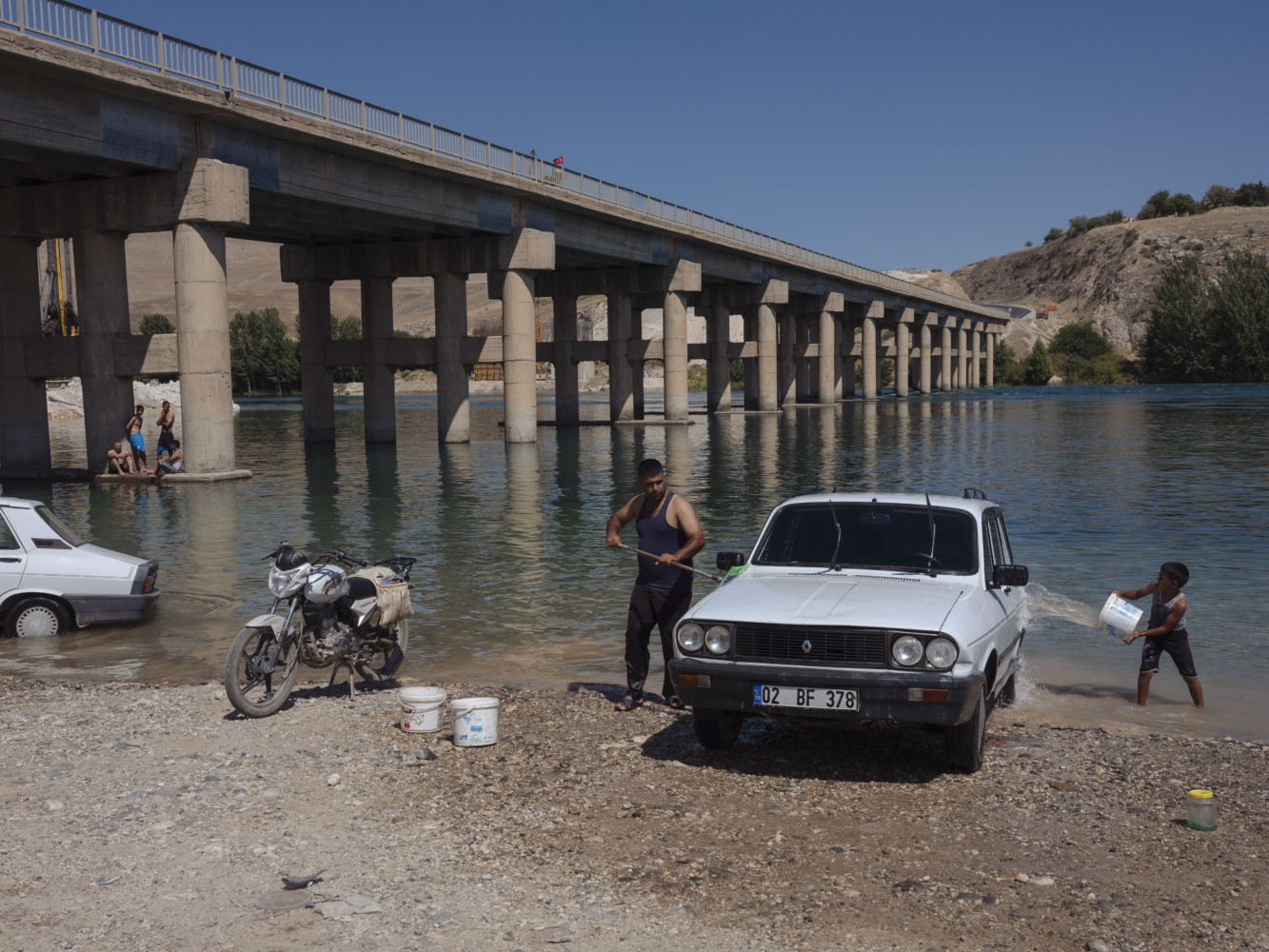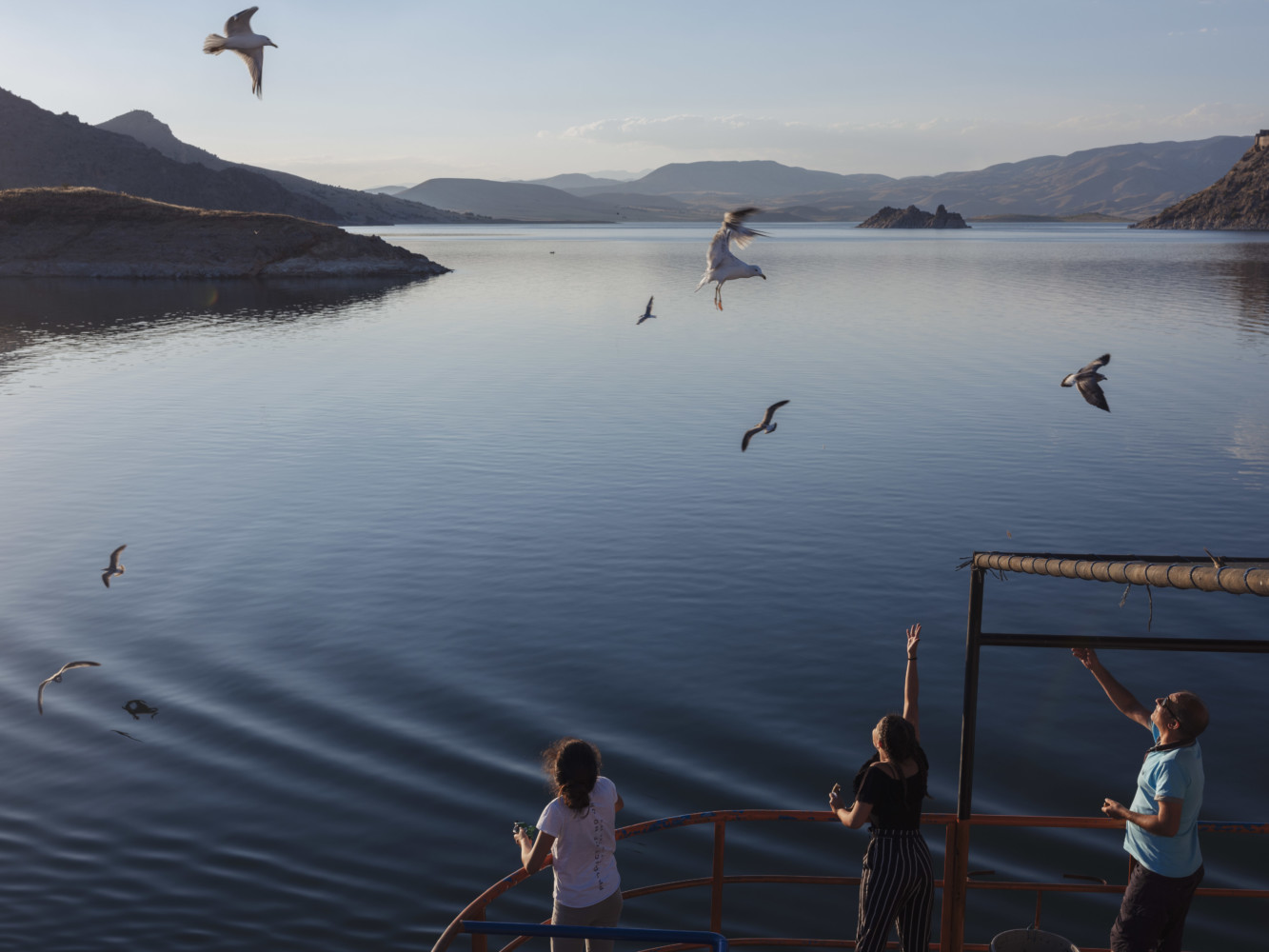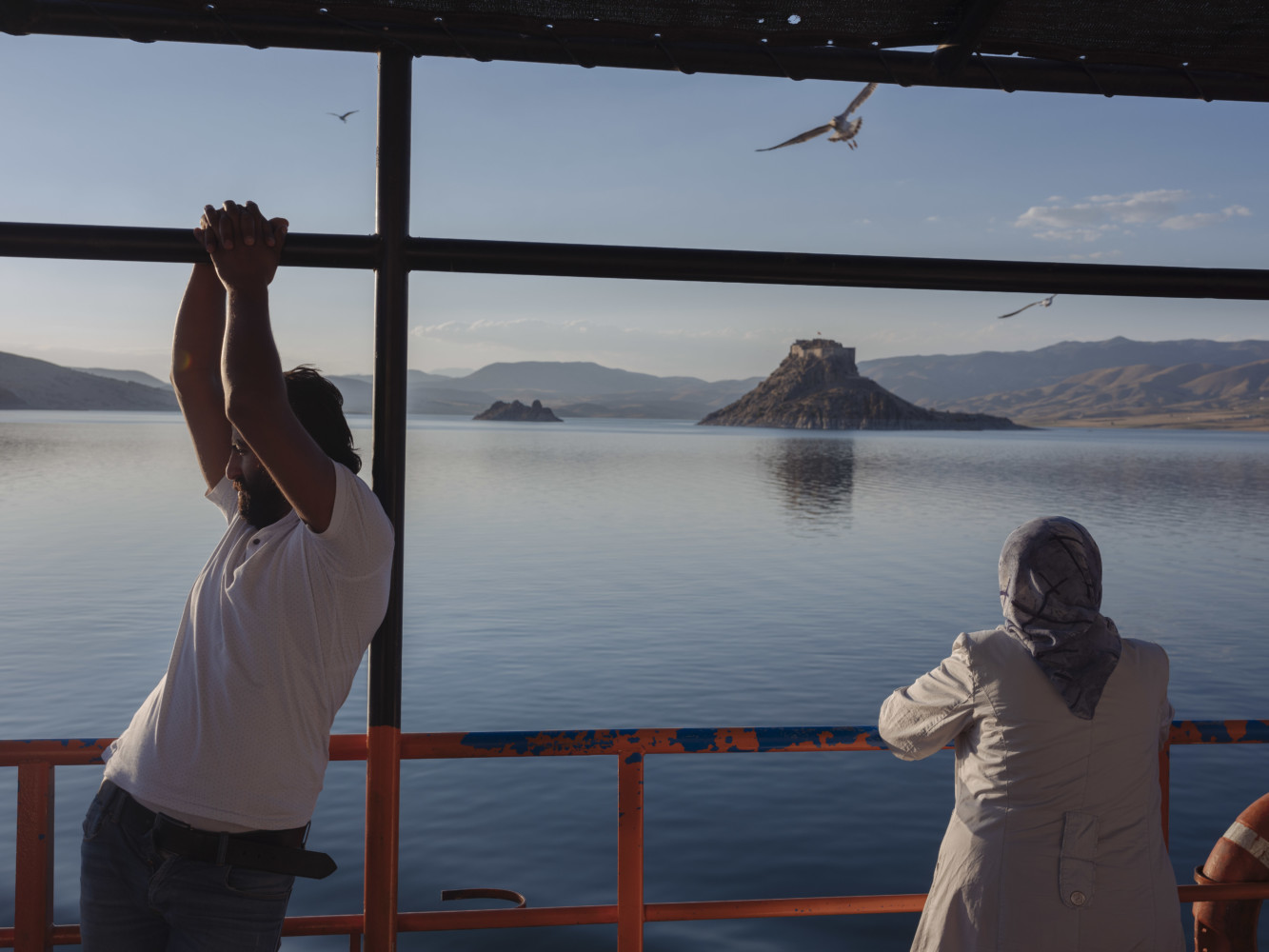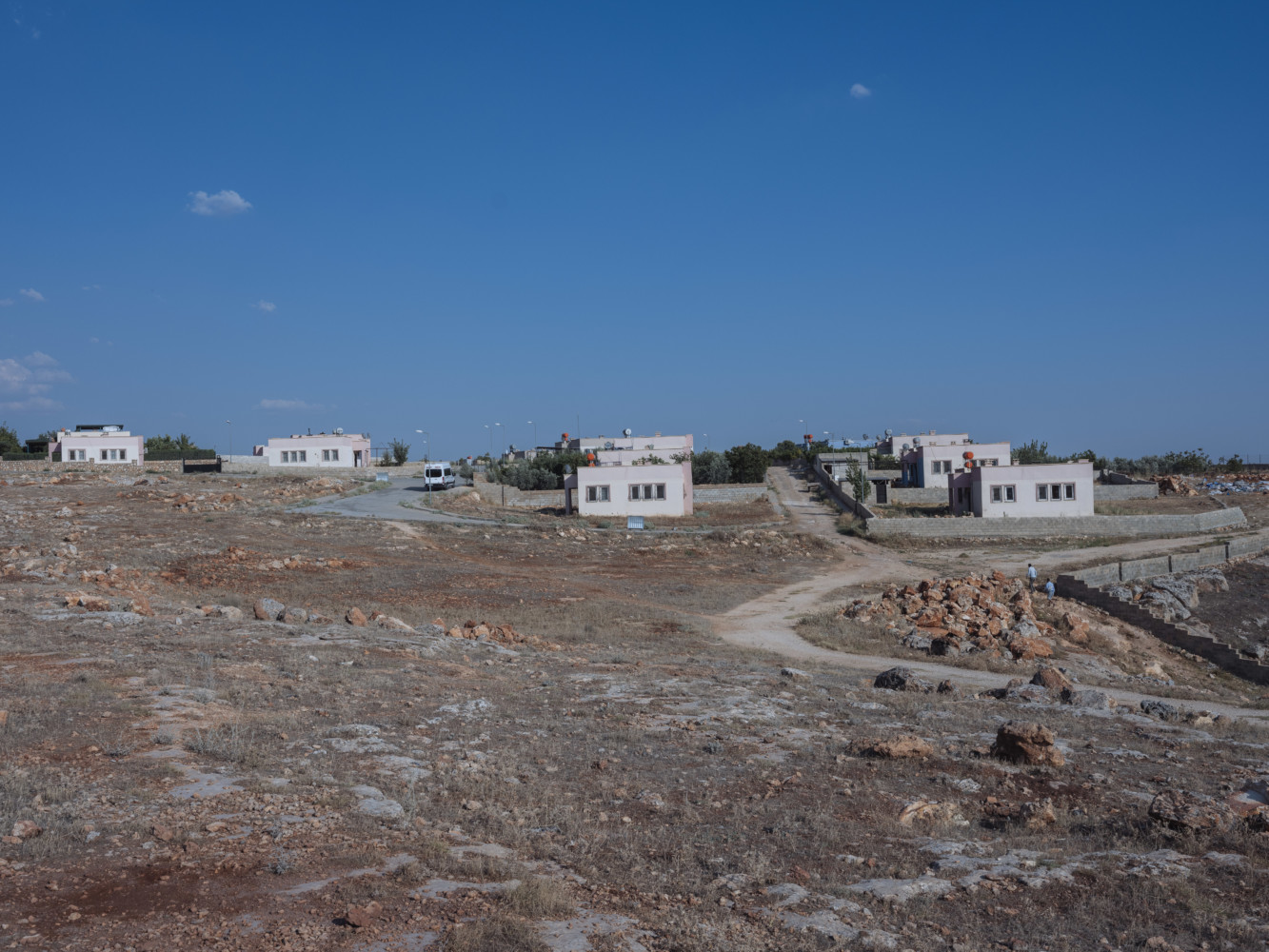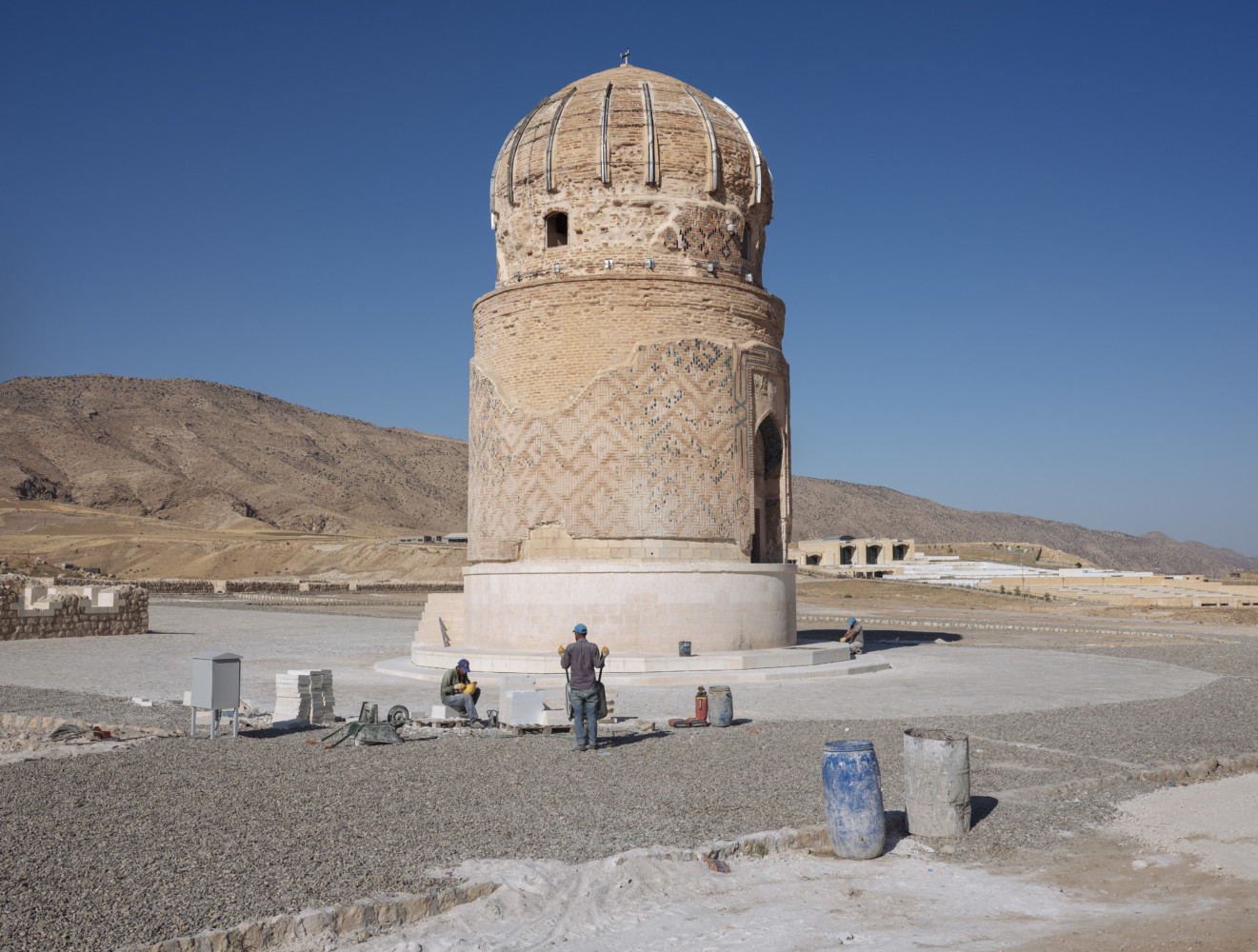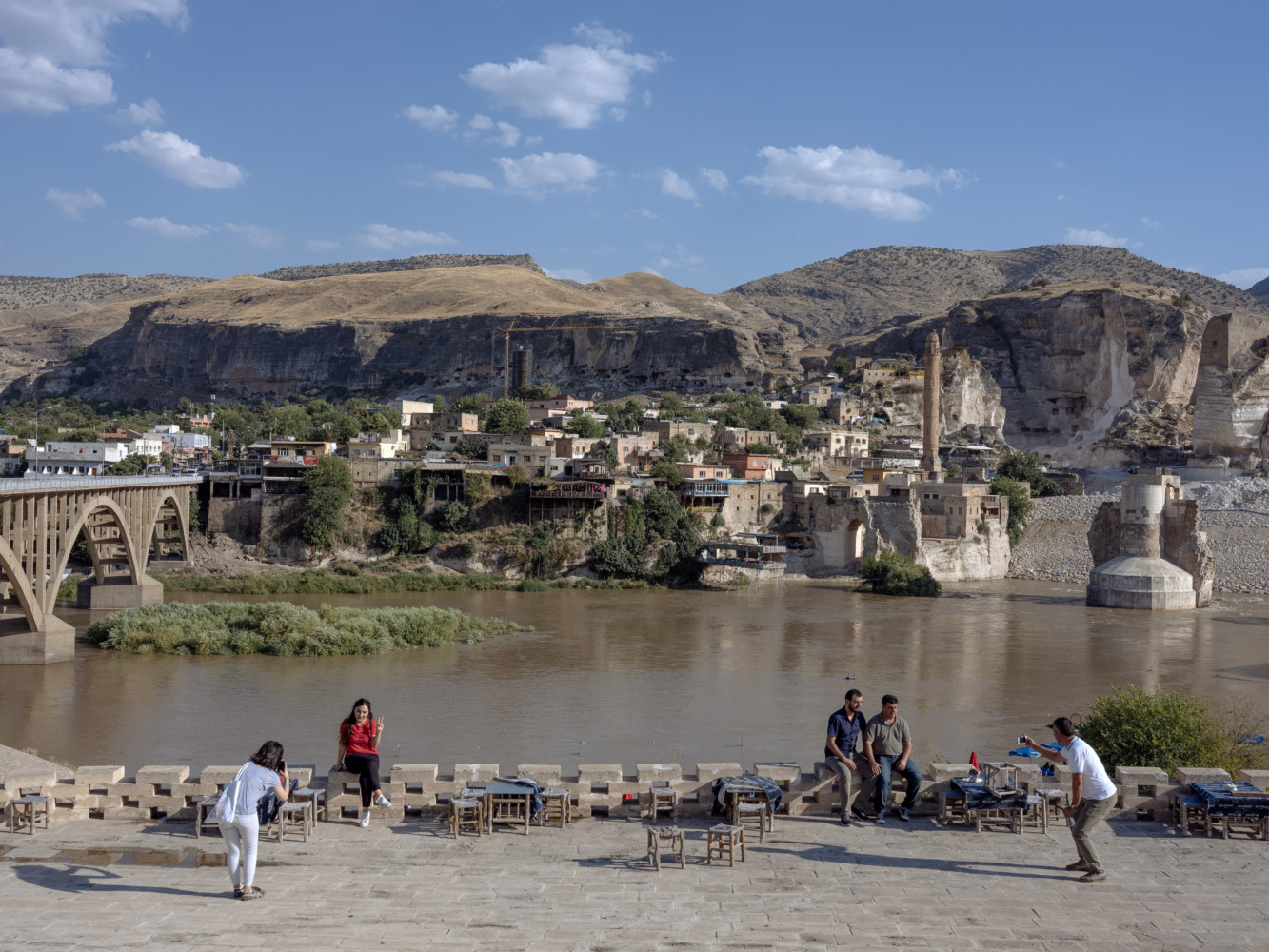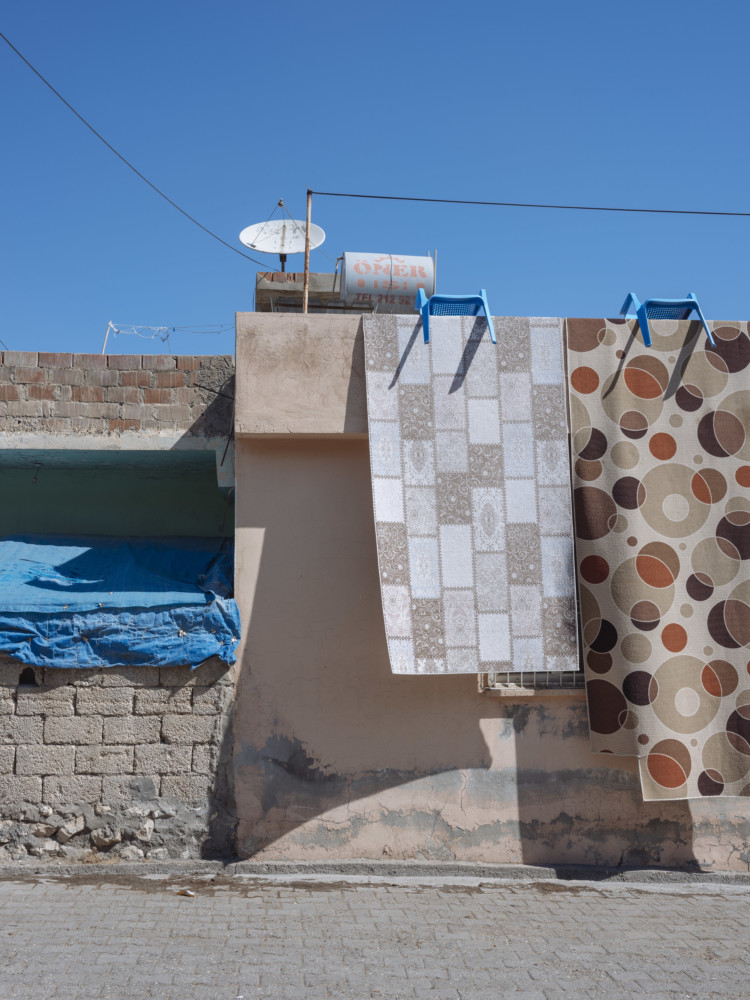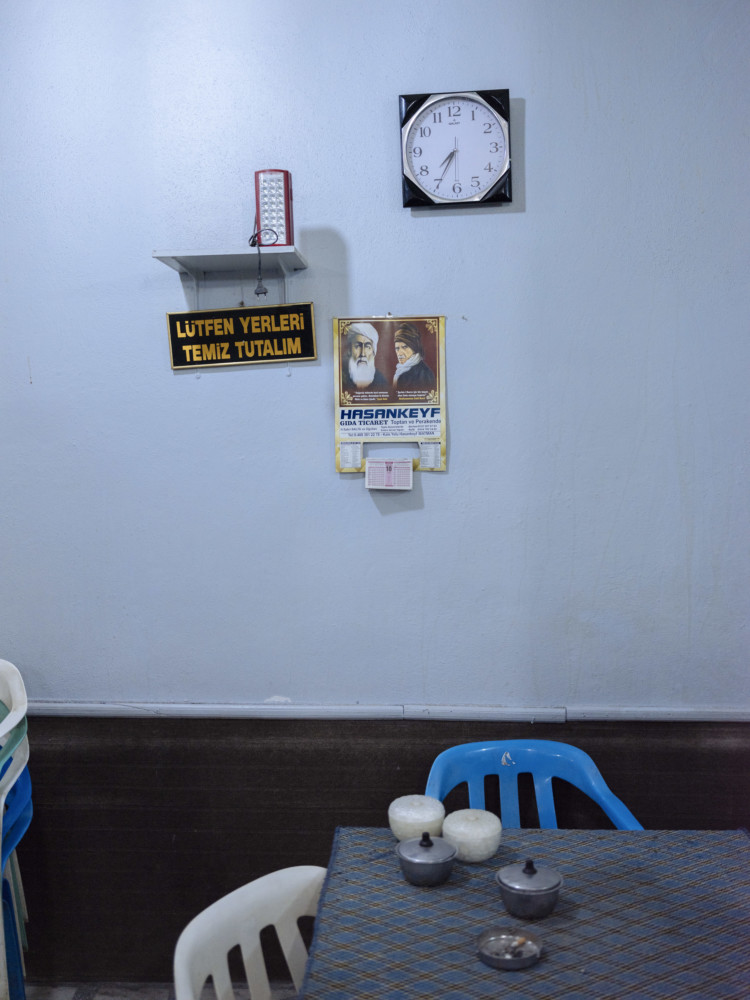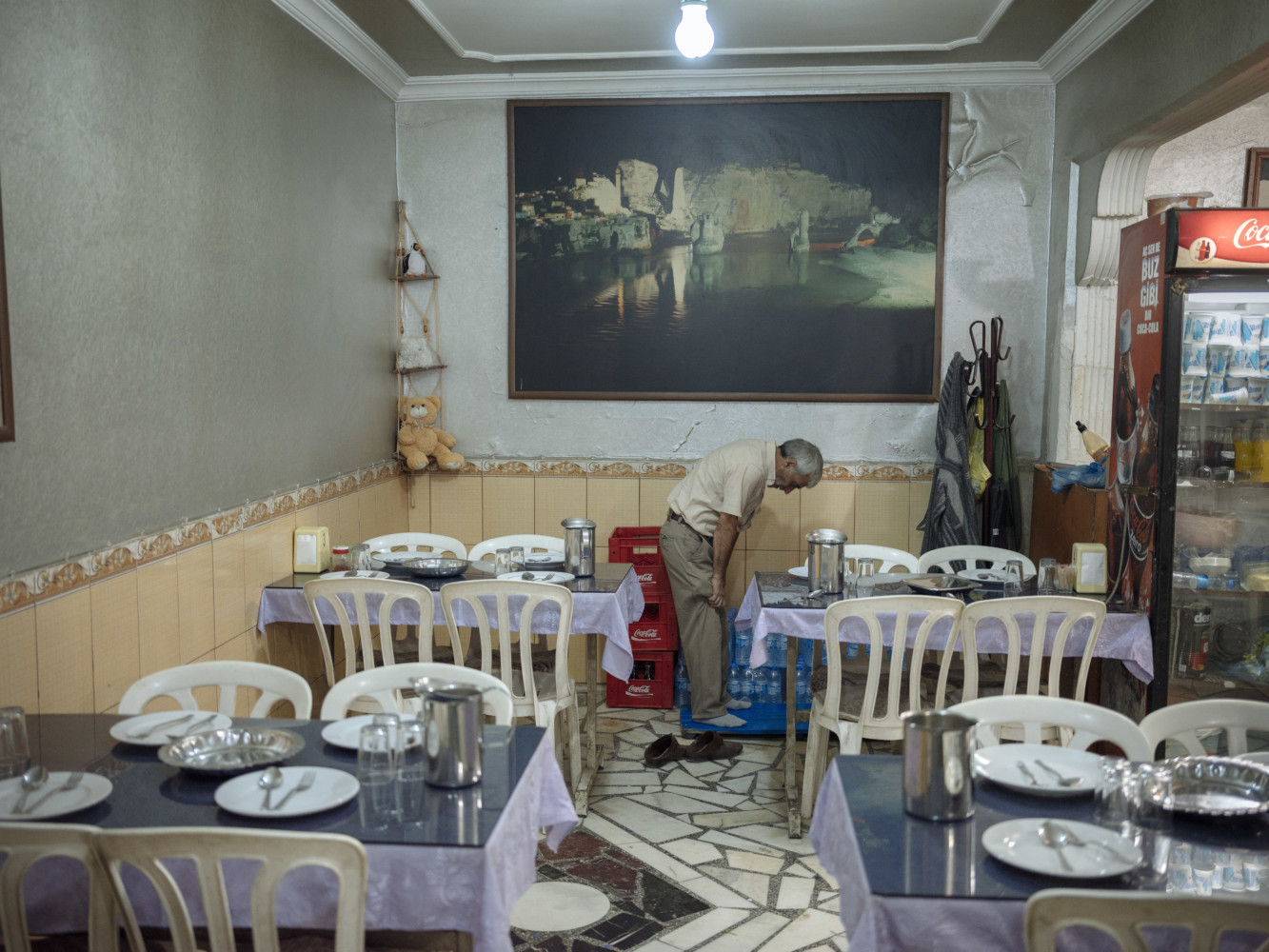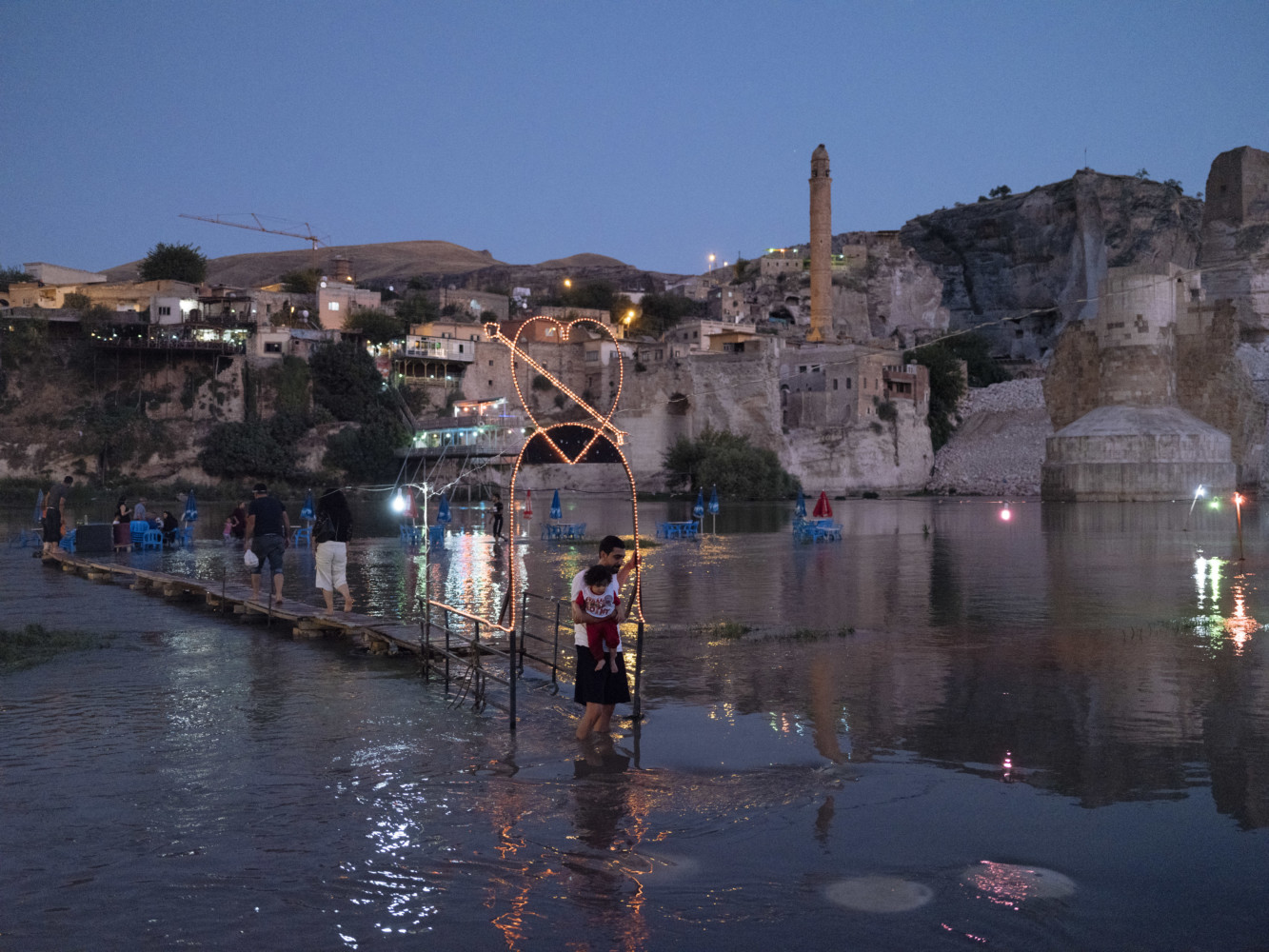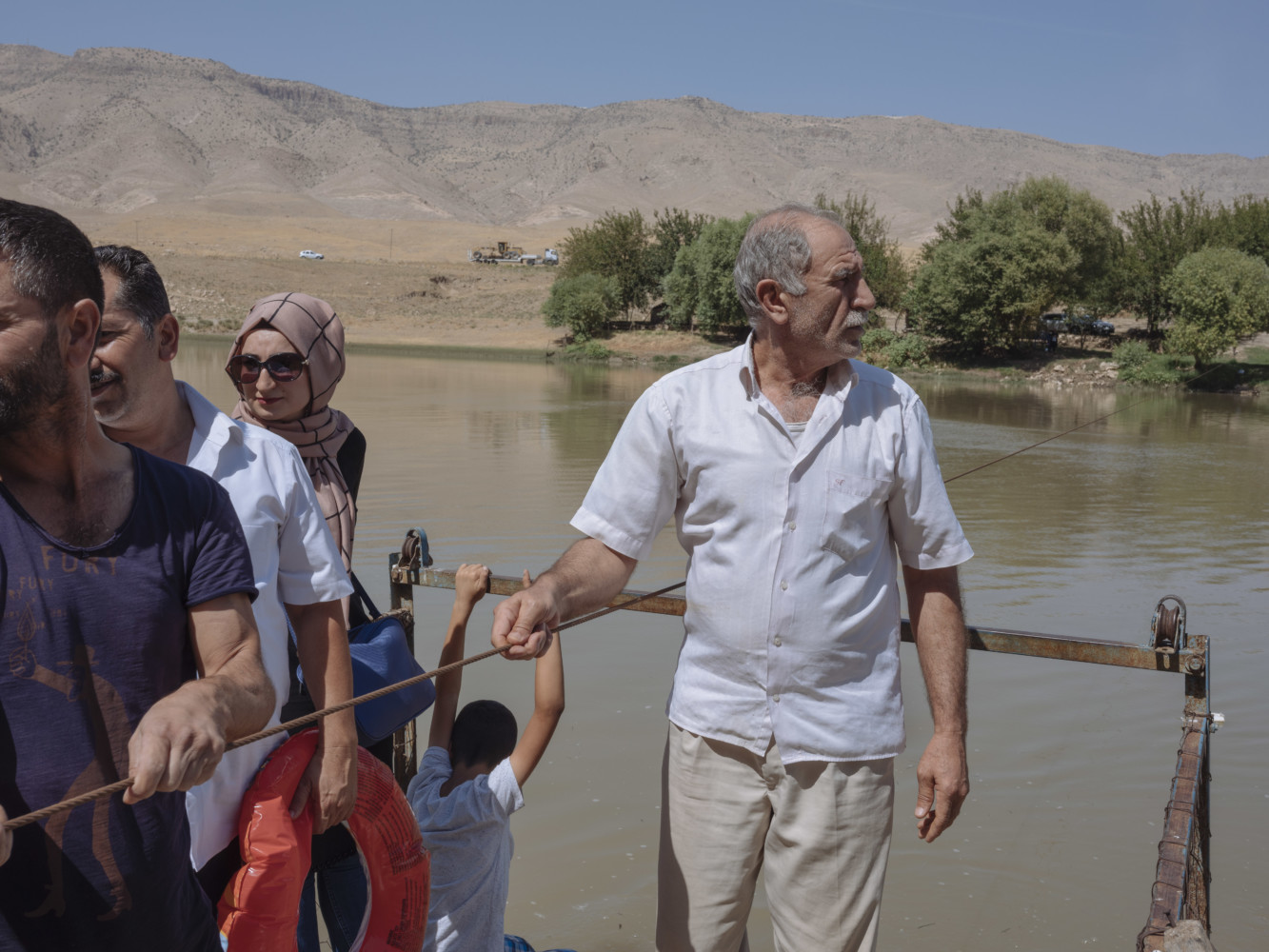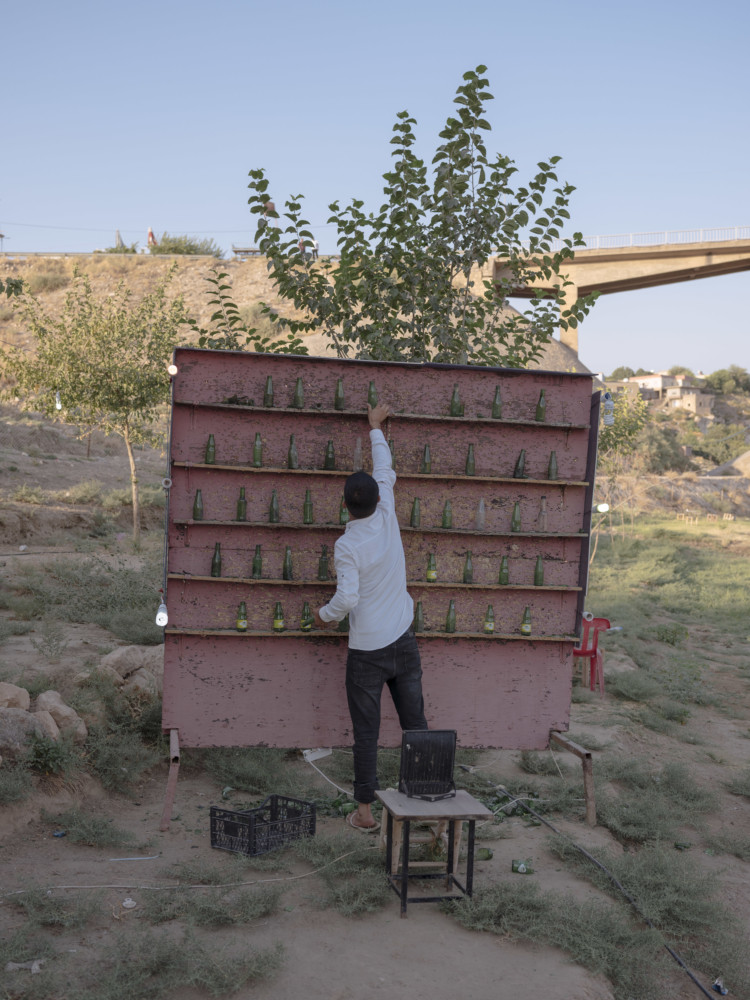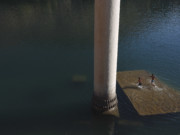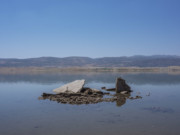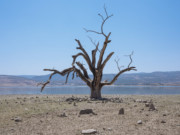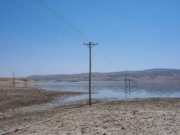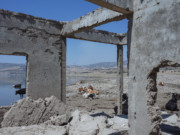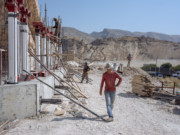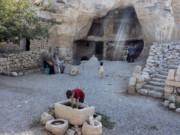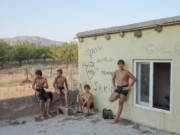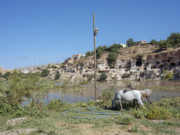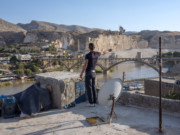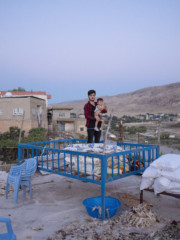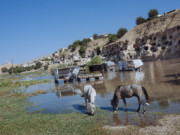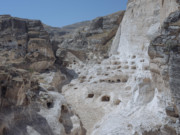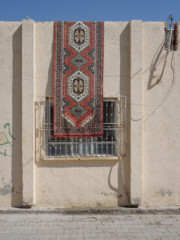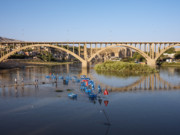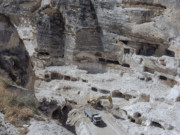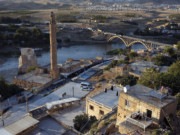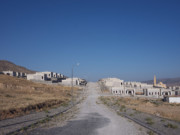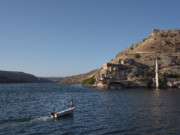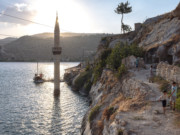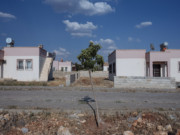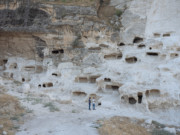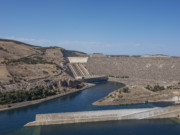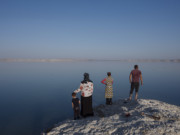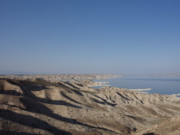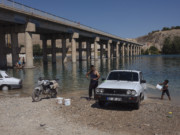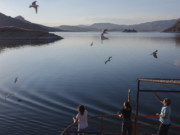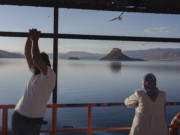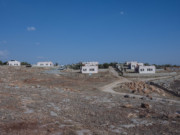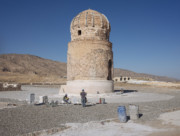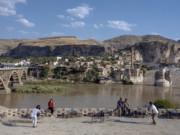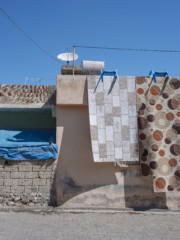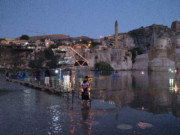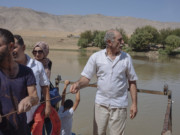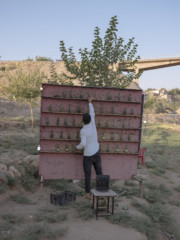Emin Özmen The remains of a sunken village near the Batman dam (completed in 1998). Of this seventy-five houses’ village, there is nothing left. Only two buildings partly damaged can be seen, including the re (...)
mains of this mosque where a dozen of cows are now drinking and resting. Hewre, Turkey. 2018. © Emin Özmen | Magnum Photos
Emin Özmen Construction workers prepare Imam Abdullah mosauleum to move it to the "New Hasankeyf"
The authorities have launched the move of eight emblematic monuments of the city near the "New Hasankeyf". Th (...)
e aim is to preserve this heritage in order to continue to attract tourists. They are now settled in a kind of archaeological park. Hasankeyf, Turkey. 2018. © Emin Özmen | Magnum Photos
Emin Özmen People visit "Kasri Rabi" caves that date back to 1270's.
The city, whose first settlements date back 12,000 years, has an exceptional archaeological heritage: Assyrian, Roman and Ottoman monument (...)
s, thousand-year-old troglodyte houses, remains of a stone bridge and a 12th century mosque are part of it.
Hasankeyf is however condemned to disappear under the water due to the construction of the Ilisu dam on the Tigris River. It will be the second largest dam in the country, is at stake. Started in 2006, the project would bring "the greatest benefit" to the people as the current President Recep Tayyip Erdoğan, then Prime Minister, promised.
A total of 70,000 people will be displaced and dozens of villages condemned to disappear. Hasankeyf, Turkey. 2018. © Emin Özmen | Magnum Photos
Emin Özmen Turkey, Kesmekopru, 2018. Hakim flies his pigeons on his rooftop's house in Kesmekopru. He owns 15 pigeons and says that they are everything for him. It takes his stress away and he just want to sp (...)
end all his time with them.
The village shares the same destiny with Hasankeyf and will be drown soon. After the completion of Ilisi Dam. A total of 70,000 people will be displaced and dozens of villages condemned to disappear. © Emin Özmen | Magnum Photos
Emin Özmen Kids rest near a small village pool.
The village shares the same destiny with Hasankeyf and will be drown soon.
After the completion of Ilisi Dam. A total of 70,000 people will be displaced and (...)
dozens of villages condemned to disappear. Kesmekopru, Turkey. 2018. © Emin Özmen | Magnum Photos
Emin Özmen Horses near Tigris River in Hasankeyf.
The city, whose first settlements date back 12,000 years, has an exceptional archaeological heritage: Assyrian, Roman and Ottoman monuments, thousand-year-o (...)
ld troglodyte houses, remains of a stone bridge and a 12th century mosque are part of it.
Hasankeyf is however condemned to disappear under the water due to the construction of the Ilisu dam on the Tigris River. It will be the second largest dam in the country, is at stake. Started in 2006, the project would bring "the greatest benefit" to the people as the current President Recep Tayyip Erdoğan, then Prime Minister, promised.
A total of 70,000 people will be displaced and dozens of villages condemned to disappear. Hasankeyf, Turkey. 2018. © Emin Özmen | Magnum Photos
Emin Özmen A kid sleeps in a house in Kesmekopru. Kesmekopru, Turkey. 2018.
The village shares the same destiny with Hasankeyf and will be drown soon. After the completion of Ilisi Dam. A total of 70,000 p (...)
eople will be displaced and dozens of villages condemned to disappear.
Tensions exist between the inhabitants of Kesmeköprü village and those of Hasankeyf. It is therefore not possible for them to move to the "New city" which would be able to accommodate them. They have no idea where they will go once their village disappears under water. Maybe in a big city nearby: Batman or Diyarbakir. © Emin Özmen | Magnum Photos
Emin Özmen Yunus, 22 years old, flies his birds on his house's roof. He's unemployed and have to take care of his family since his father died. For the moment they live thanks to their fig trees. They sell th (...)
e fruits in Batman's markets.
The village in which he lives (Kesmeköprü), very close to Hasankeyf, offers an incredible view on the millennial city, but also, now, on the cliff destroyed with dynamite (on the right). Kesmekopru, Turkey. 2018. © Emin Özmen | Magnum Photos
Emin Özmen Women chat near a balcony in Kesmekopru. Kesmekopru, Turkey. 2018.
The village shares the same destiny with Hasankeyf and will be drown soon. After the completion of Ilisi Dam. A total of 70,000 (...)
people will be displaced and dozens of villages condemned to disappear.
Tensions exist between the inhabitants of this Ke?meköprü village and those of Hasankeyf. It is therefore not possible for them to move to the "New city" which would be able to accommodate them. They have no idea where they will go once their village disappears under water. Maybe in a big city nearby: Batman or Diyarbakir. © Emin Özmen | Magnum Photos
Emin Özmen Hundreds of caves newly discovered on the construction site of Hasankeyf,
They're destined to be submerged in water in a few months.
The city, whose first settlements date back 12,000 years, ha (...)
s an exceptional archaeological heritage: Assyrian, Roman and Ottoman monuments, thousand-year-old troglodyte houses, remains of a stone bridge and a 12th century mosque are part of it.
Hasankeyf is however condemned to disappear under the water due to the construction of the Ilisu dam on the Tigris River. It will be the second largest dam in the country, is at stake. Started in 2006, the project would bring "the greatest benefit" to the people as the current President Recep Tayyip Erdoğan, then Prime Minister, promised.
A total of 70,000 people will be displaced and dozens of villages condemned to disappear.
Hasankeyf, Turkey. 2018. © Emin Özmen | Magnum Photos
Emin Özmen Hundreds of caves newly discovered on the construction site of Hasankeyf,
They're destined to be submerged in water in a few months.
The city, whose first settlements date back 12,000 years, ha (...)
s an exceptional archaeological heritage: Assyrian, Roman and Ottoman monuments, thousand-year-old troglodyte houses, remains of a stone bridge and a 12th century mosque are part of it.
Hasankeyf is however condemned to disappear under the water due to the construction of the Ilisu dam on the Tigris River. It will be the second largest dam in the country, is at stake. Started in 2006, the project would bring "the greatest benefit" to the people as the current President Recep Tayyip Erdoğan, then Prime Minister, promised.
A total of 70,000 people will be displaced and dozens of villages condemned to disappear. Hasankeyf, Turkey. 2018. © Emin Özmen | Magnum Photos
Emin Özmen General view of New Hasankeyf.
The approximately 6,000 people threatened by the submergence had their homes bought by the government, which built a new town less than two kilometers away from the (...)
old one. Composed of 710 soulless houses erected by the Ministry of Collective Housing (TOKI), the administrative services have already moved there. Hasankeyf, Turkey. 2018. © Emin Özmen | Magnum Photos
Emin Özmen Hasan is the owner of a straw huts built on stilts. He has worked and lived here for 19 years. He doesn't know what he'll do once the city is sunken. City officials told him not to worry. Thanks to (...)
the rising waters, he will be able to open a new café in the new city.
He gets upset explaining to me that it is not comparable, there is not this view, there are not these grapes, even less his precious fig trees on which he collects fruits every day. He is tired of not knowing what tomorrow will be like. Hasankeyf, Turkey. 2018. © Emin Özmen | Magnum Photos
Emin Özmen Children play in the water, on the roof of a partially sunken mosque in Savasan.
The village (only accessible by boat) attracts all the attention. More than 200,000 visitors come every year to adm (...)
ire a minaret’s visible above the water. The rest of the city disappeared after Birecik dam's construction. Halfeti, Turkey. 2018. © Emin Özmen | Magnum Photos
Emin Özmen Men play cards in a small tea house of Hasankeyf old town.
The city, whose first settlements date back 12,000 years, has an exceptional archaeological heritage: Assyrian, Roman and Ottoman monume (...)
nts, thousand-year-old troglodyte houses, remains of a stone bridge and a 12th century mosque are part of it. Hasankeyf, Turkey. 2018.
Hasankeyf is however condemned to disappear under the water due to the construction of the Ilisu dam on the Tigris River. It will be the second largest dam in the country, is at stake. Started in 2006, the project would bring "the greatest benefit" to the people as the current President Recep Tayyip Erdoğan, then Prime Minister, promised.
A total of 70,000 people will be displaced and dozens of villages condemned to disappear. © Emin Özmen | Magnum Photos
Emin Özmen Kids on a boat heading to Savasan village in old Halfeti.
The village (only accessible by boat) attracts all the attention. More than 200,000 visitors come every year to admire a minaret’s visibl (...)
e above the water. The rest of the city disappeared after Birecik dam's construction. Halfeti, Turkey. 2018. © Emin Özmen | Magnum Photos
Emin Özmen Turkey, Hasankeyf, 2018. A view in the interior of a small restaurant in Hasankeyf.
The city, whose first settlements date back 12,000 years, has an exceptional archaeological heritage: Assyrian, (...)
Roman and Ottoman monuments, thousand-year-old troglodyte houses, remains of a stone bridge and a 12th century mosque are part of it.
Hasankeyf is however condemned to disappear under the water due to the construction of the Ilisu dam on the Tigris River. It will be the second largest dam in the country, is at stake. Started in 2006, the project would bring "the greatest benefit" to the people as the current President Recep Tayyip Erdo?an, then Prime Minister, promised.
A total of 70,000 people will be displaced and dozens of villages condemned to disappear. © Emin Özmen | Magnum Photos
Emin Özmen A general view of "New Halfeti".
Following the construction of the Birecik dam downstream and the flooding of the area in 2000, "old Halfeti" 's inhabitants were evacuated. They now live 8 kilome (...)
ters away from this typical village, in new apartments built at the top of the hill. It is called the "new Halfeti". Soulless, arid, sorrowful. Halfeti, Turkey. 2018. © Emin Özmen | Magnum Photos
Emin Özmen Turkey, Hasankeyf, 2018. Young men stand next to caves, newly discovered on the construction site. They're destined to be submerged in water in a few months.
The city, whose first settlements date (...)
back 12,000 years, has an exceptional archaeological heritage: Assyrian, Roman and Ottoman monuments, thousand-year-old troglodyte houses, remains of a stone bridge and a 12th century mosque are part of it.
Hasankeyf is however condemned to disappear under the water due to the construction of the Ilisu dam on the Tigris River. It will be the second largest dam in the country, is at stake. Started in 2006, the project would bring "the greatest benefit" to the people as the current President Recep Tayyip Erdo?an, then Prime Minister, promised.
A total of 70,000 people will be displaced and dozens of villages condemned to disappear. © Emin Özmen | Magnum Photos
Emin Özmen General view of Ataturk dam, one of the largest dams in the country. It is located on the Euphrates river in Bozova (south-east Turkey). Construction of the dam and the hydroelectric power project (...)
(HEPP) was undertaken from 1983 to 1990. Hasankeyf, Turkey. 2018. © Emin Özmen | Magnum Photos
Emin Özmen A family stands near their sunken village close to Samsat.
Samsat was built in the 1980s to accommodate the inhabitants of the ancient village submerged by the waters of Atatürk dam’s reservoir in (...)
1989. But the "new city" of Samsat has been hit by two consecutive earthquakes (the last of which occurred in April 2018). More than 3,000 homes were seriously damaged. The government has started construction of 403 new homes, meanwhile families are living in a prefabricated buildings camp.
Turkey, Adiyaman, 2018. © Emin Özmen | Magnum Photos
Emin Özmen People cross Euphrates River by boat, the fastest way to reach the opposite bank. She enjoys the view of the Keban Dam reservoir lake.
The Dam, filled from 1973, is the first major one built on (...)
the Euphrates - It is part of the "GAP" project - in Turkish: "Güneydoğu Anadolu Projesi" = "Southeastern Anatolia Project" . Led by the Turkish government, it consists of the construction of 22 dams - 19 of which coupled with hydroelectric power stations.
Elazig, Turkey. 2018. © Emin Özmen | Magnum Photos
Emin Özmen Turkey, Halfeti, 2018. A general view of "New Halfeti".
Following the construction of the Birecik dam downstream and the flooding of the area in 2000, "old Halfeti" 's inhabitants were evacuated. (...)
They now live 8 kilometers away from this typical village, in new apartments built at the top of the hill. It is called the "new Halfeti". Soulless, arid, sorrowful. © Emin Özmen | Magnum Photos
Emin Özmen People work near Zeynel Bey mausoleum, just settled in its new place in the "New Hasankeyf"
The authorities have launched the move of eight emblematic monuments of the city near the "New Hasankey (...)
f". The aim is to preserve this heritage in order to continue to attract tourists. They are now settled in a kind of archaeological park. Hasankeyf, Turkey. 2018. © Emin Özmen | Magnum Photos
Emin Özmen Turkey, Hasankeyf, 2018. Inside a typical tea house where nothing seems to have changed since the 1960s.
The city, whose first settlements date back 12,000 years, has an exceptional archaeological (...)
heritage: Assyrian, Roman and Ottoman monuments, thousand-year-old troglodyte houses, remains of a stone bridge and a 12th century mosque are part of it.
Hasankeyf is however condemned to disappear under the water due to the construction of the Ilisu dam on the Tigris River. It will be the second largest dam in the country, is at stake. Started in 2006, the project would bring "the greatest benefit" to the people as the current President Recep Tayyip Erdo?an, then Prime Minister, promised.
A total of 70,000 people will be displaced and dozens of villages condemned to disappear. © Emin Özmen | Magnum Photos
Emin Özmen Turkey, Hasankeyf, 2018. A man prays in a restaurant.
The city, whose first settlements date back 12,000 years, has an exceptional archaeological heritage: Assyrian, Roman and Ottoman monuments, t (...)
housand-year-old troglodyte houses, remains of a stone bridge and a 12th century mosque are part of it.
Hasankeyf is however condemned to disappear under the water due to the construction of the Ilisu dam on the Tigris River. It will be the second largest dam in the country, is at stake. Started in 2006, the project would bring "the greatest benefit" to the people as the current President Recep Tayyip Erdo?an, then Prime Minister, promised.
A total of 70,000 people will be displaced and dozens of villages condemned to disappear. © Emin Özmen | Magnum Photos
Emin Özmen People walk on a makeshift bridge that lead to a restaurant settled on the Tigris River. A few local tourists enjoy the freshness of the evening.
The city, whose first settlements date back 12,000 (...)
years, has an exceptional archaeological heritage: Assyrian, Roman and Ottoman monuments, thousand-year-old troglodyte houses, remains of a stone bridge and a 12th century mosque are part of it.
Hasankeyf is however condemned to disappear under the water due to the construction of the Ilisu dam on the Tigris River. It will be the second largest dam in the country, is at stake. Started in 2006, the project would bring "the greatest benefit" to the people as the current President Recep Tayyip Erdogan, then Prime Minister, promised.
A total of 70,000 people will be displaced and dozens of villages condemned to disappear. Hasankeyf, Turkey. 2018. © Emin Özmen | Magnum Photos
